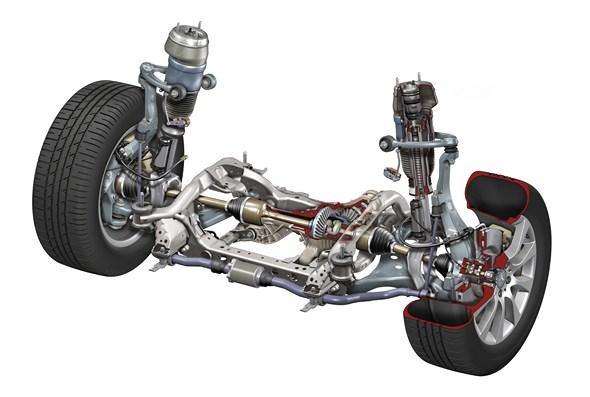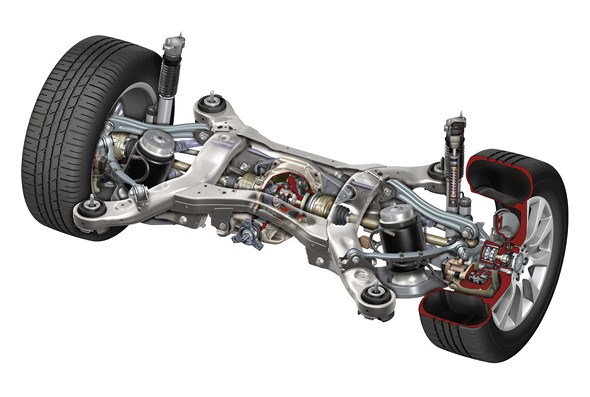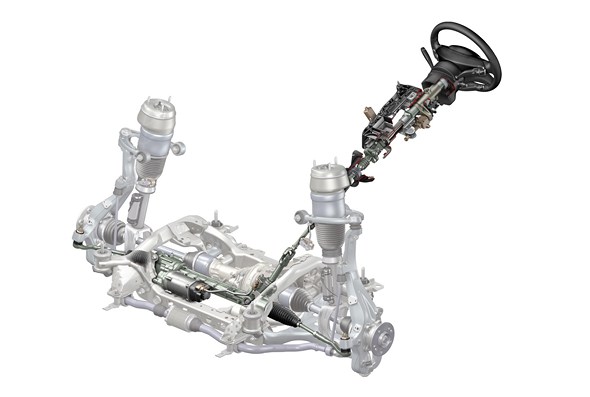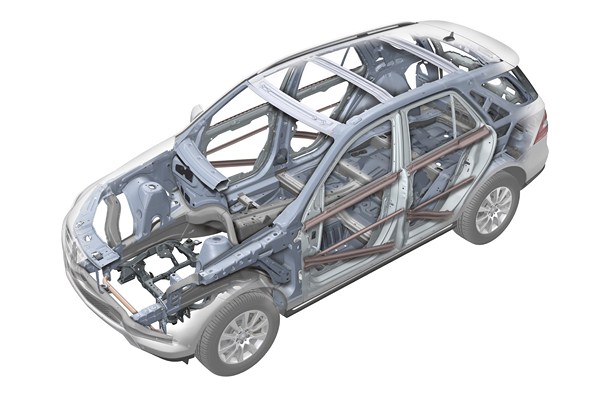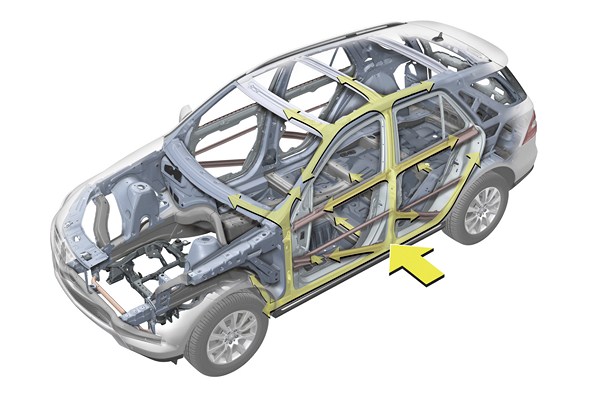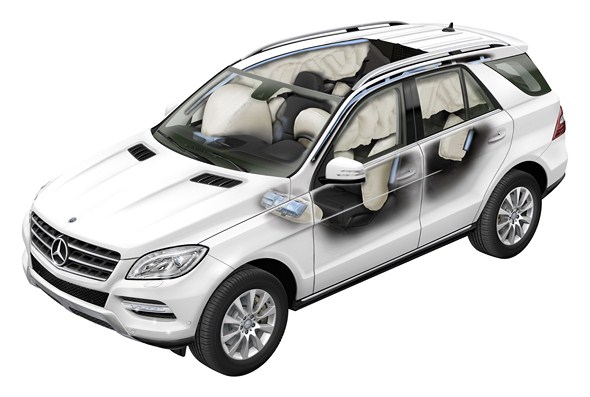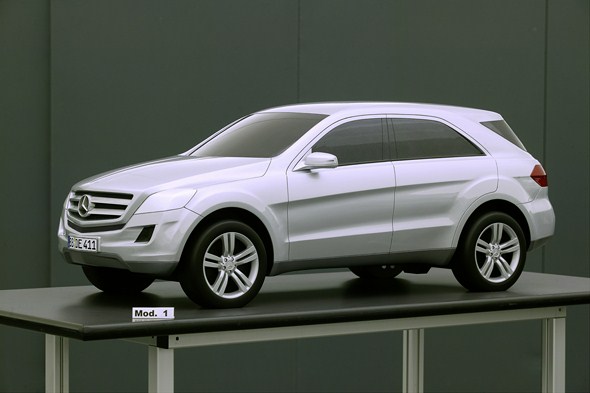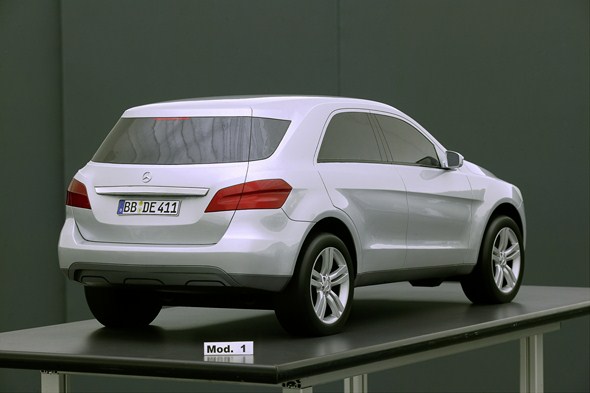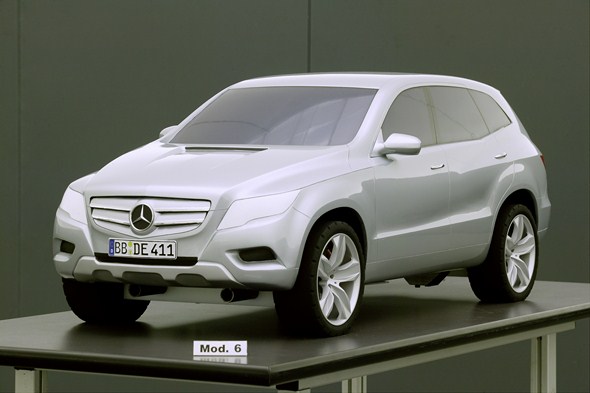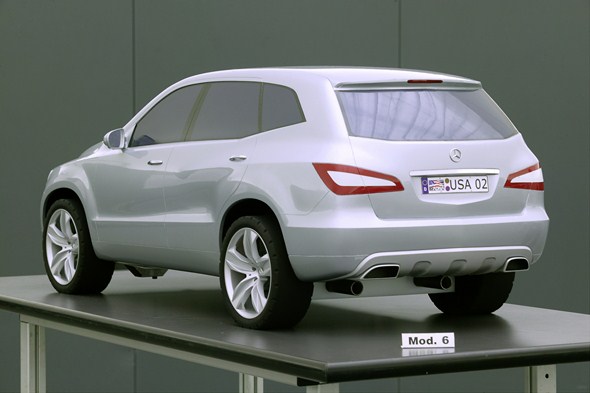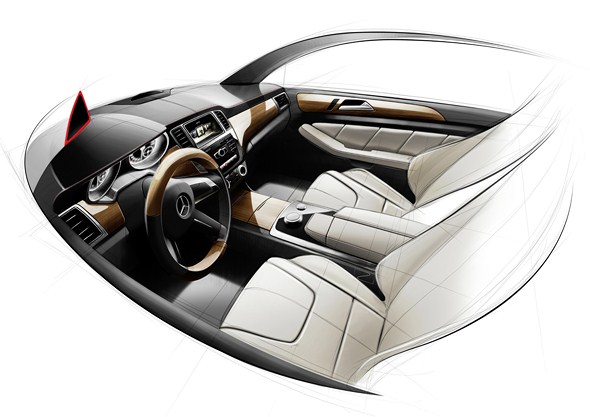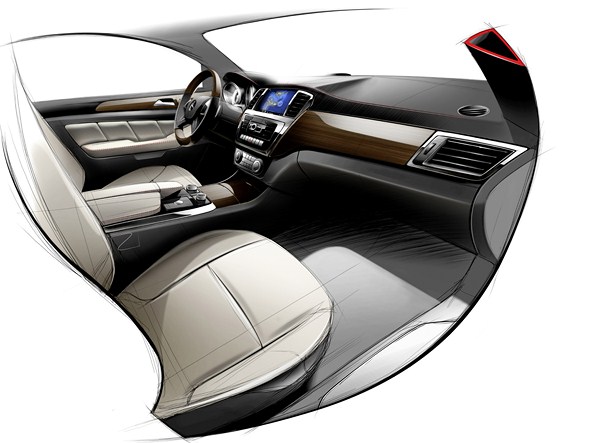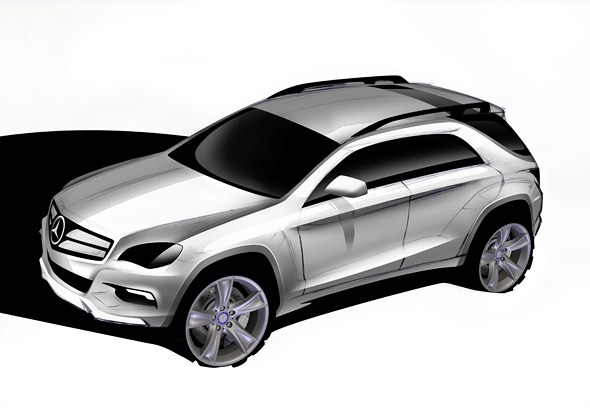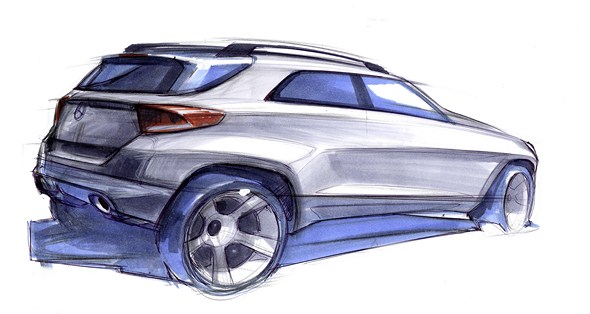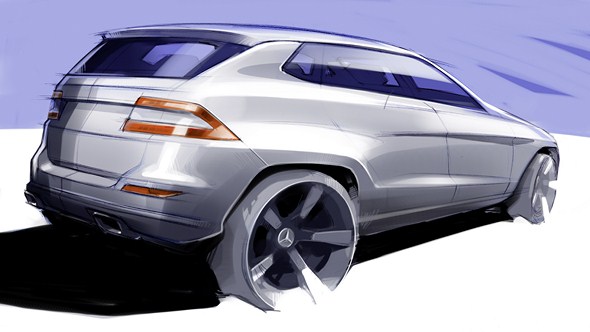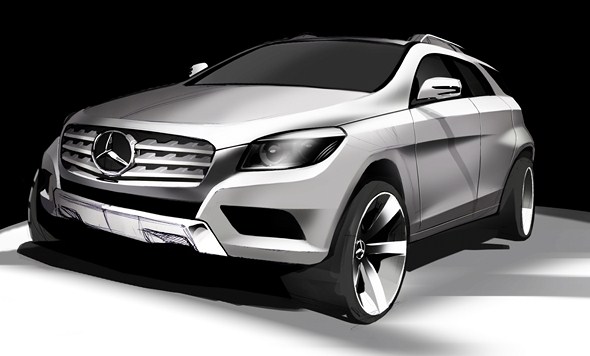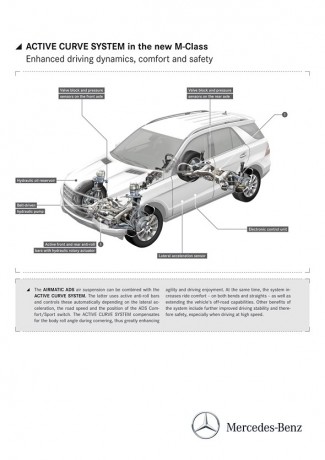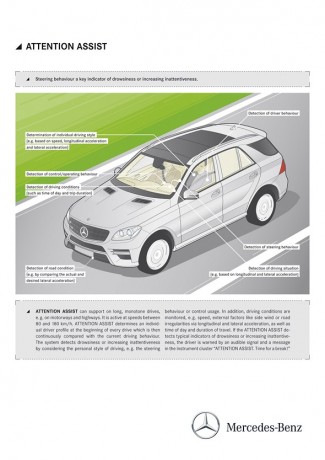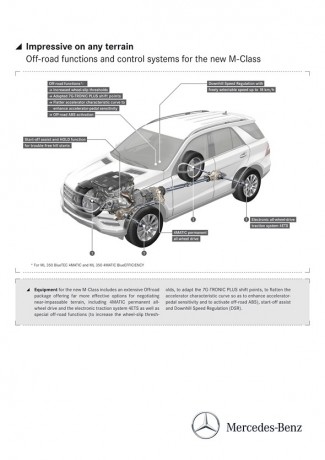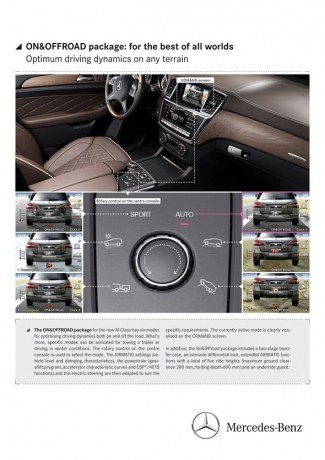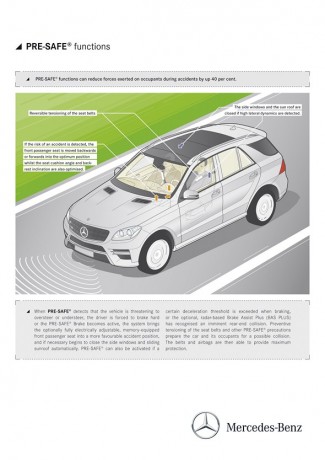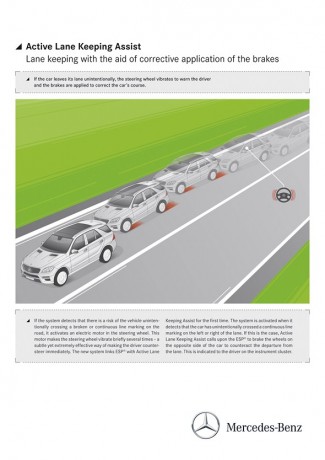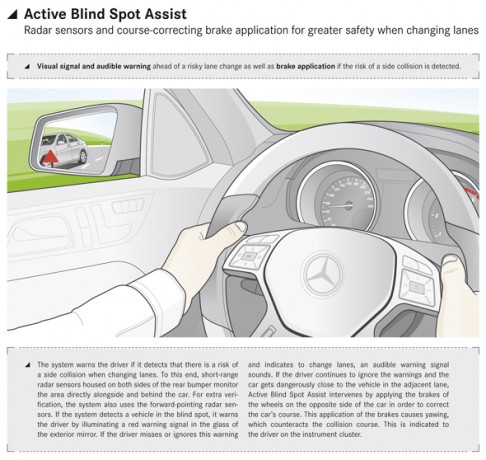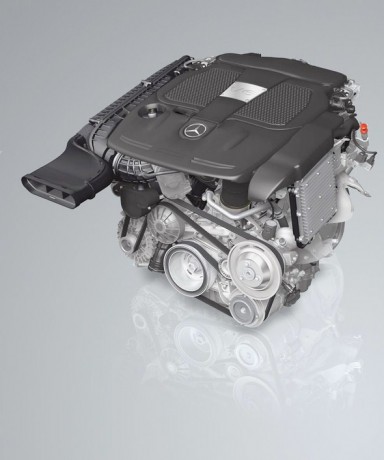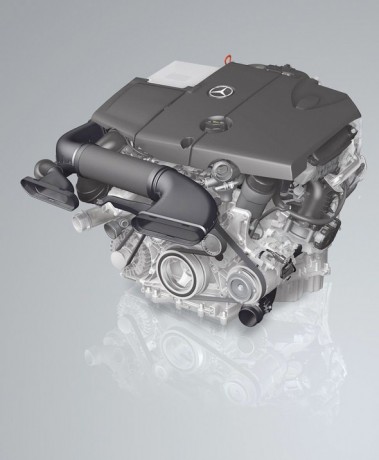A generation ahead: the new Mercedes-Benz M-Class

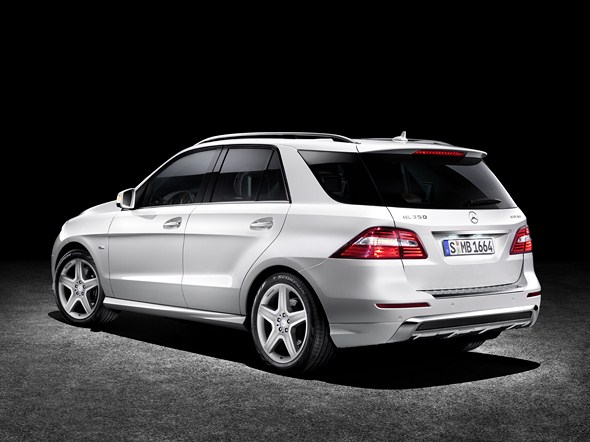
Refinement meets efficiency
Stuttgart / Kitzbühel – The third generation Mercedes-Benz M-Class scores particularly highly on outstanding energy efficiency, and on average the new model range consumes 25 percent less fuel than the previous models. One true champion in terms of fuel consumption is the ML 250 BlueTEC 4MATIC, which boasts an NEDC consumption of just 6.0 l/100 km (158 g CO2/km) and has a range of up to 1500 kilometres on a full tank.
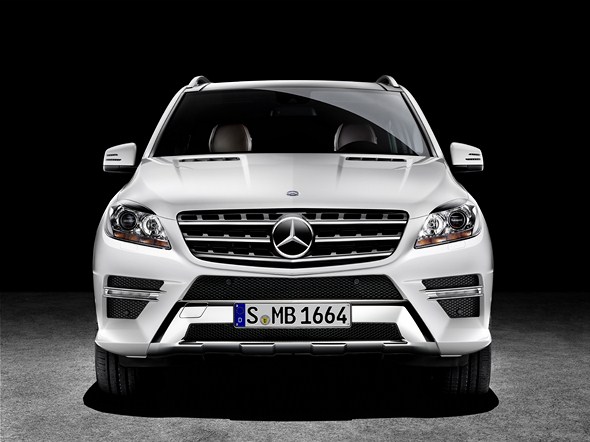
Further strengths of the premium SUV with permanent all-wheel drive include exceptional safety and well-balanced ride comfort as well as excellent driving dynamics both on and off the road. What’s more, the ML features an array of new chassis developments and innovative dynamic handling control systems which further enhance both driving enjoyment and handling safety. A characteristic body design and a variable interior with a high wellness factor add to the richness of the driving experience in the new M-Class.
Dr. Thomas Weber, member of the Board of Management of Daimler AG with responsibility for Group Research and Mercedes-Benz Cars Development, puts it in a nutshell: “With the M-Class, it’s always been a case of combining the comfort and luxury of a saloon car with the off-road characteristics and the emotiveness of an SUV.
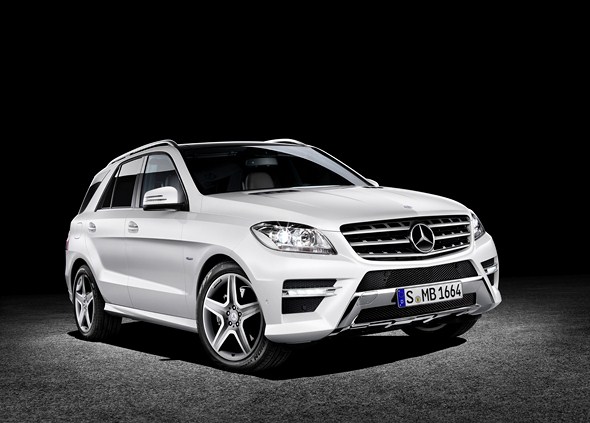
The fact that the new M-Class is as fuel-efficient as the economical saloon cars displaying the Mercedes star makes the all-wheel-drive model even more desirable. A range of state-of-the-art engines, a class-leading cd figure (drag coefficient) of 0.32 and extensive BlueEFFICIENCY measures lay the foundations for outstanding energy efficiency.
Complete and attractively priced model range
Despite the substantially upgraded equipment and appointments, prices for the ML 350 BlueTEC 4MATIC remain practically the same as for its predecessor (an increase of just 50 euros).
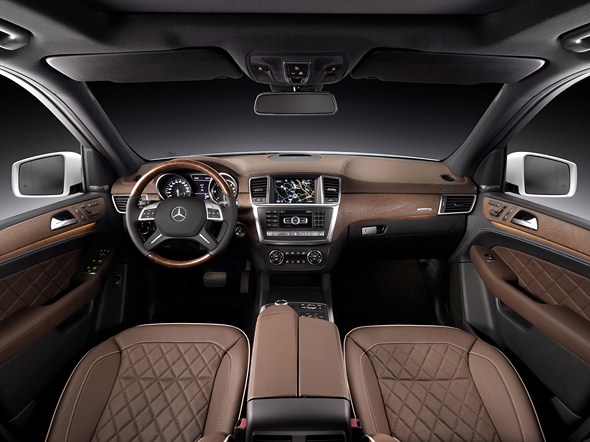
The prices at a glance:
| incl. 19% VAT | ||
| ML 250 BlueTEC 4MATIC | €46,200 | €54,978 |
| ML 350 BlueTEC 4MATIC | €49,350 | €58,726.50 |
| ML 350 4MATIC BlueEFFICIENCY | €47,700 | €56,763 |
According to Dr. Joachim Schmidt, Board Member of Mercedes-Benz Cars, Sales & Marketing: “The M-Class is a story of success. With more than 1.2 million vehicles sold, it is the best-selling SUV in its segment and also enjoys the loyalest customer base. We will be continuing this success with the new M-Class, which will make an important contribution to our sales growth over the coming years.”
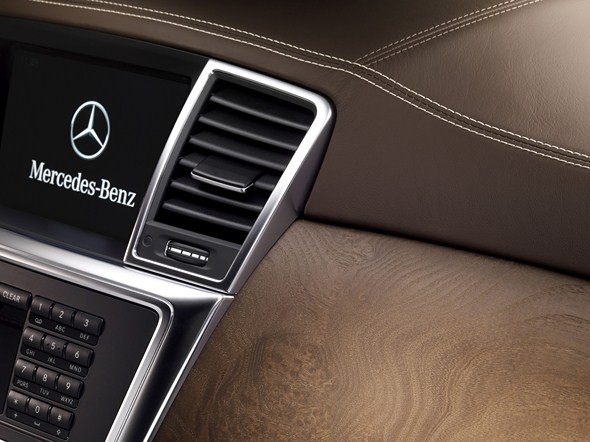
To mark the launch of the new M-Class, there will be a limited special-edition model available in the shape of the Edition 1. This exclusive model includes an AMG Exterior Sports package and features an impressive and particularly exclusive interior. Prices start at €55,700 (€66,283 incl. 19% VAT) for the ML 250 BlueTEC 4MATIC Edition 1. Delivery of the M-Class to customers
will commence in November this year.
A model of success: the M-Class sets new standards in the world of the SUV
BlueTEC diesel units and the new generation of BlueDIRECT petrol engines ensure excellent economy and an outstanding life cycle assessment of the new M-Class. As Dr. Schmidt explains further: “The new M-Class has the potential to set standards in the SUV world once again: one average it consumes one quarter less fuel than its predecessor and as such will be the most economical vehicle in its segment – whether fitted with or without a hybrid drive.”
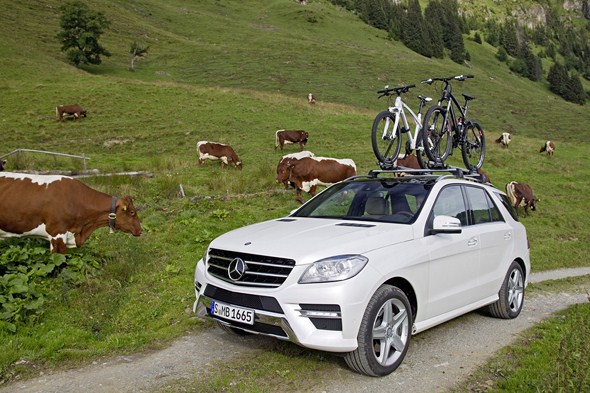
As far as the diesel engines are concerned, now available solely as BlueTEC units with SCR emissions technology, the focus is firmly on downsizing and on the new version of the V6 CDI engine:
- In the ML 250 BlueTEC 4MATIC, the 3.0-litre V6 of the previous ML 300 CDI BlueEFFICIENCY 4MATIC model is replaced by the thrifty four-cylinder unit already familiar from, for instance, the S-Class. TheNEDC consumption of 6.0 l/100 km is 28 percent lower than that of the previous model.
- The ML 350 BlueTEC 4MATIC features an extensively revamped 3.0-‑litre V6 which offers far better performance coupled with a substantial reduction in fuel consumption. This version boasts an NEDC figure of just 6.8 l/100 km, a 24-percent improvement compared to the previous ML 350 CDI 4MATIC model.
Thanks to AdBlue® emission control technology both diesel models comfortably meet the EU6 standard slated for introduction in 2014.

The ML 350 4MATIC BlueEFFICIENCY petrol-engine model, on the other hand, delivers a convincing performance thanks to the technical details of the new BlueDIRECT engine generation. The key here is the third-generation direct petrol injection system with spray-guided combustion and new piezo injectors that have an injection pressure of 200 bar, together with multi-spark ignition (MSI) and a new stratified combustion process.
In this case, the NEDC consumption of 8.5 l/100 km is 25 percent lower than that of the previous ML 350 4MATIC model. The ML 350 4MATIC BlueEFFICIENCY meets the requirements of the EU5 standard, currently the strictest standard in force for petrol models.
Long-distance champion: a high level of efficiency ensures a long range
The range calculated for a full tank of fuel is particularly impressive. With an NEDC consumption of 6.0 l/100 km, the ML 250 BlueTEC 4MATIC with the standard 70-litre tank can cover around 1170 kilometres before needing to stop for fuel. If the vehicle is fitted with the optional 93-litre tank, the car can even cover up to 1500 kilometres between refuelling stops.
| ML 250 BlueTEC4MATIC | ML 350 BlueTEC4MATIC | ML 350 4MATIC BlueEFFICIENCY | ||||
| NEDC combined l/100 km | 6.0 | 6.8 | 8.5 | |||
| Tank capacitylitres | 70 | 93 | 70 | 93 | 78 | 93 |
| Range per full tankkm | 1170 | 1500 | 1030 | 1370 | 920 | 1090 |
The excellent fuel economy is underpinned by a comprehensive package of BlueEFFICIENCY measures as well as by this state-of-the-art engineering. In addition to the ECO start/stop function that comes as standard, these measures include the new seven-speed 7G/TRONIC PLUS automatic transmission with a new fuel-economy converter, friction-optimised bearings and a transmission oil thermal management system.
Low-friction axle drives, electric steering, the optimised belt drive with decoupler, the on-demand control of all ancillary components and pumps, and tyres with low rolling resistance also play their part in reducing fuel consumption. What’s more, intelligent lightweight design has stopped the weight from spiralling upwards.
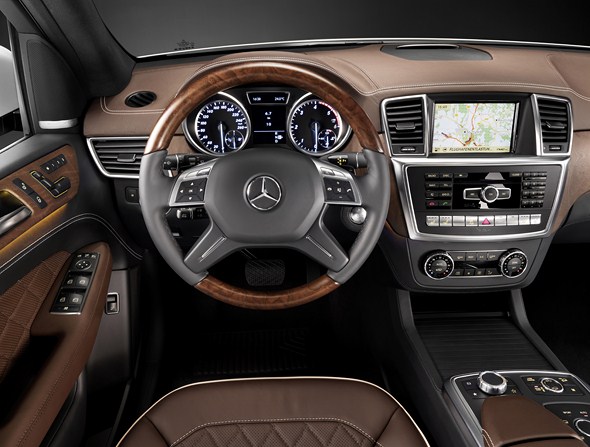
With a drag coefficient, or cd figure, of 0.32, the new M-Class (ML 250 BlueTEC) also sets a new best figure for this vehicle class. Intensive simulations undertaken with the digital prototype, along with final touches added in the wind tunnel, ensure a perfect flow of air around the vehicle.
The key factor determining the low wind resistance is the aerodynamic efficiency of the basic body shell, including the optimised design of the front bumper, of the A-pillars and of the roof spoiler, plus numerous other detailed improvements.
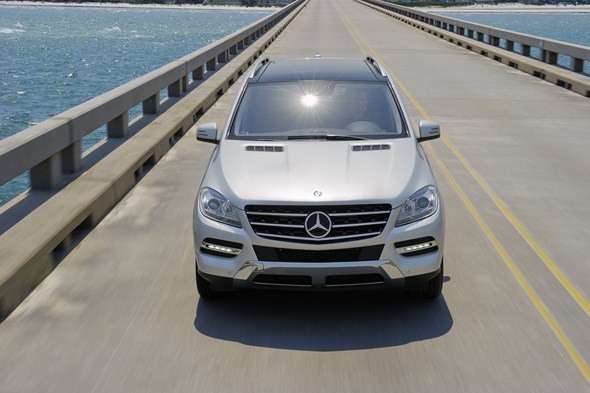
The result: a high level of comfort and outstanding driving dynamics on and off the road
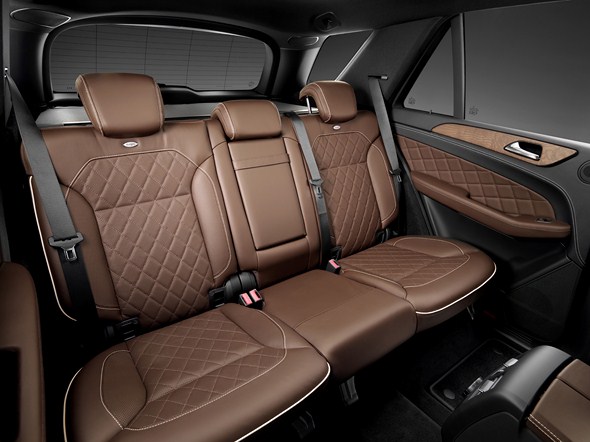
Even the standard version of the new M-Class offers a high level of comfort, dynamic on-road handling and outstanding off-road capabilities. For the first time, the M-Class chassis with steel suspension features selective damping.
The driver is assisted by electric steering, which ensures the optimum level of steering assistance for the current driving situation. In addition to this, the SUV impresses with the smallest turning circle in its market segment.
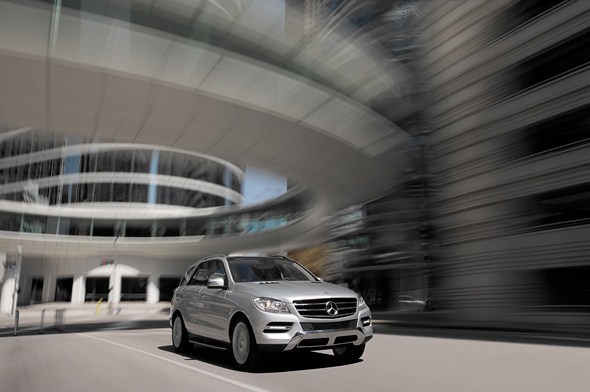
For driving off the beaten track, the ML 350 BlueTEC 4MATIC and ML 350 4MATIC BlueEFFICIENCY models are equipped with extensive off-road features as standard, including 4MATIC permanent all-wheel drive, 4ETS electronic traction control and an off-road button which activates a special off‑road driving mode.
Furthermore, the start-off assist system makes hill starts easier, while the Downhill Speed Regulation (DSR) automatically keeps the M‑Class at the speed set using the cruise control stalk.
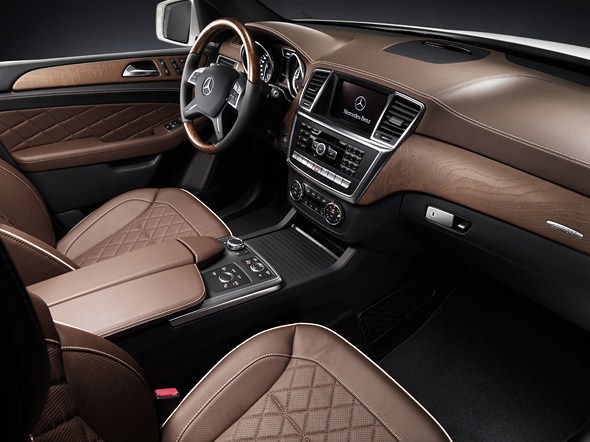
The optional ON&OFFROAD package for the new M-Class has six driving modes for optimising driving dynamics and handling safety, as the optimum drive system control is provided for an extremely wide range of on-road and off-road operating conditions.
The driver can select from one automatic mode, two special off-road modes and three on-road modes using a rotary control in the centre console.
In terms of “hardware”, the ON&OFFROAD package comprises an underguard, a two-stage transfer case with reduction gear, an inter-axle differential lock and enhanced AIRMATIC functionality that allows a maximum ground clearance of 285 millimetres as well as a fording depth of 600 millimetres.
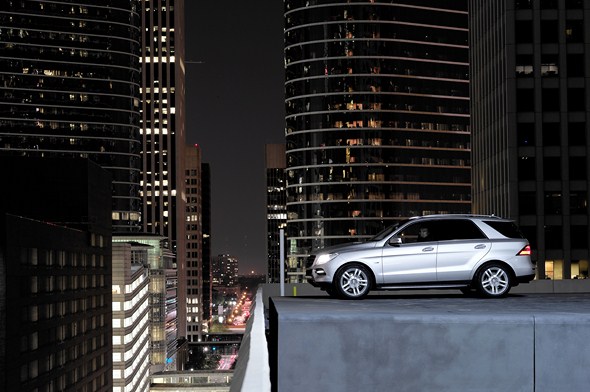
Active roll stabilisation in the form of the ACTIVE CURVE SYSTEM can be optionally combined with both the AIRMATIC air suspension with Adaptive Damping System (ADS) and the ON&OFFROAD package. This system uses active anti-roll bars on the front and rear axles and compensates for the roll angle of the body through bends, increasing agility and driving pleasure in the process.
The system has the additional effect of increasing handing stability and therefore safety, particularly at higher speeds. Further benefits of the ACTIVE CURVE SYSTEM include superb ride comfort both when cornering and driving in a straight line, together with enhanced off-road abilities.
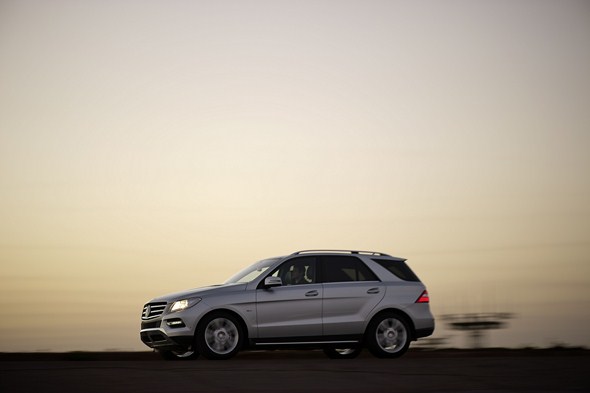
Gently does it: attention to detail ensures comfort
The new M-Class promises relaxed and, therefore, safe driving in all possible conditions. By paying close attention to detail every step of the way, the development engineers in the Mercedes Technology Center have significantly improved what they call the NVH comfort level (Noise, Vibration, Harshness).
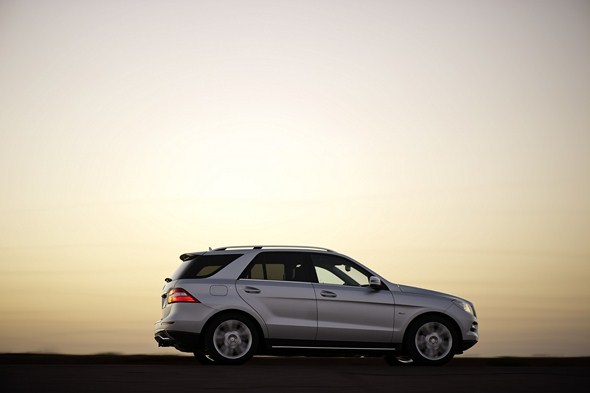
This is an important factor contributing to the general sense of wellbeing on board, whilst also playing its part in driver-fitness safety, especially on long journeys. The basis for the high level of NVH comfort is provided by the very rigid bodyshell of the M-Class. Further improvements have also been made to the drive system and chassis. This is all topped off by aero-acoustic refinements and the intelligent use of new-style insulation.
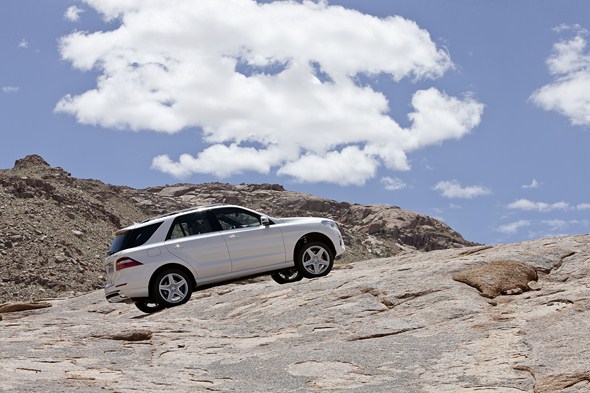
Well thought-out: safety at its best
In line with the Mercedes-Benz brand philosophy, the new M-Class represents the embodiment of the Mercedes-Benz holistic safety concept of Real Life Safety, which is derived primarily from what happens in a real accident situation.
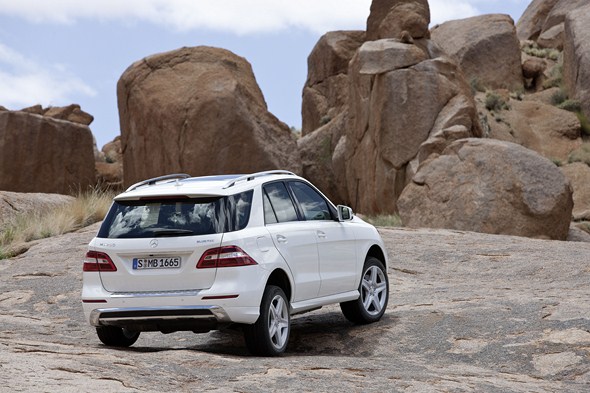
The extremely robust occupant compartment of the M-Class, together with the front and rear deformation zones, forms an effective basis for the occupant protection system. Up to nine airbags, activated on demand in accordance with the accident type and accident severity, can reduce the loads exerted on the occupants.
In addition to active safety systems such as the standard-fit Brake Assist (BAS) or the optional BAS PLUS, which can help to prevent an accident or reduce the severity of an accident, the new M-Class features further enhanced passive-safety measures to help protect pedestrians, including an Active Bonnet as standard.
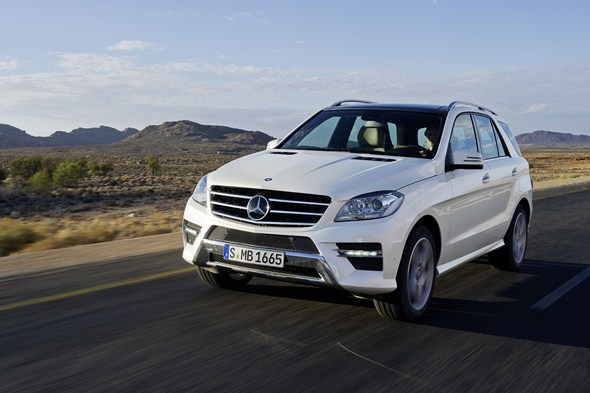
Both active safety and driver-fitness safety in the new M-Class are further improved by assistance systems that will already be familiar, primarily from the S- and E-Class. The standard equipment package includes the drowsiness detection system ATTENTION ASSIST, the anticipatory safety system PRE‑SAFE® and a tyre pressure loss warning system, as well as adaptive brake lights and Brake Assist (BAS). Active assistance systems such as Active Lane Keeping Assist and Active Blind Spot Assist are available as additional equipment options:
Impressive credentials: the design
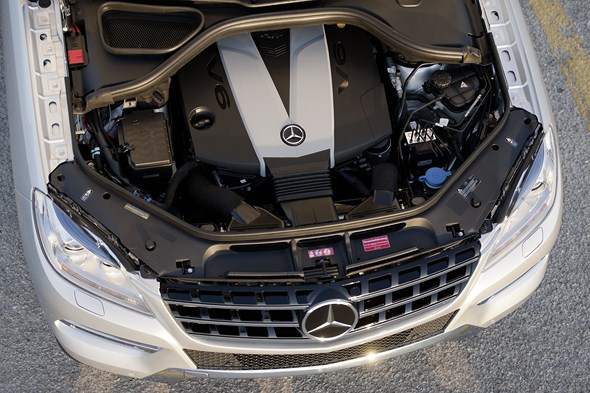
The new generation is instantly recognisable as an M-Class by its characteristic body design with the hallmark C-pillar shape. It combines high levels of design, appeal and ease of use to create a powerful presence. The front of the vehicle is dominated by the powerfully self-confident design of the radiator grille with its centrally positioned Mercedes star, giving it that typical M-Class look. Seen from the side, the elongated lines give formal emphasis to the on-road credentials of this vehicle, whose compact proportions are defined by a large wheelbase and short overhangs.
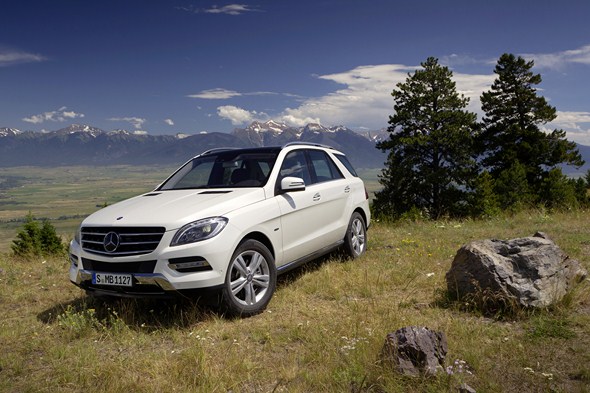
The C-pillar that is so characteristic of this model series takes its cue from earlier generations of the M-Class and differentiates it very clearly in stylistic terms from its competitors. At the same time, the way the roof line slopes down to the rear underlines the sporty appeal of the new M-Class. No pillar is visible in the transition from the rear side window through to the rear windscreen.
This, together with the similarly wrap-around effect of the two-part rear light unit with LED fibre-optic technology, and the lowered roof with its large roof spoiler, add up to an overall harmonious design. The rear bumper, which features an integrated chrome-effect load sill guard in a new “wing design”, defines the characteristic
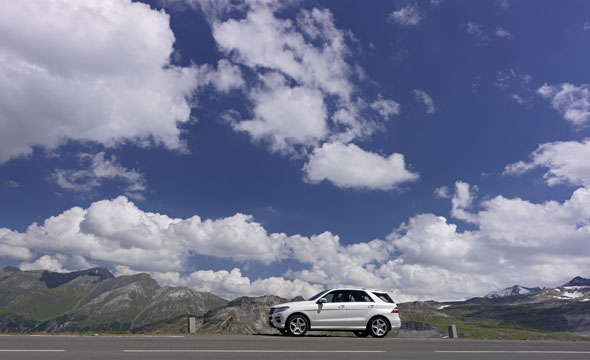
appearance of the SUV’s rear end. The available wheels range from light and aerodynamically optimised 43.2 cm (17-inch) wheels through to 50.8 cm (20‑inch) wheels with an elegant, high-quality appeal. As an option, 53.3 cm (21‑inch) AMG wheels can be fitted to emphasise the sporty look of the new M‑Class.
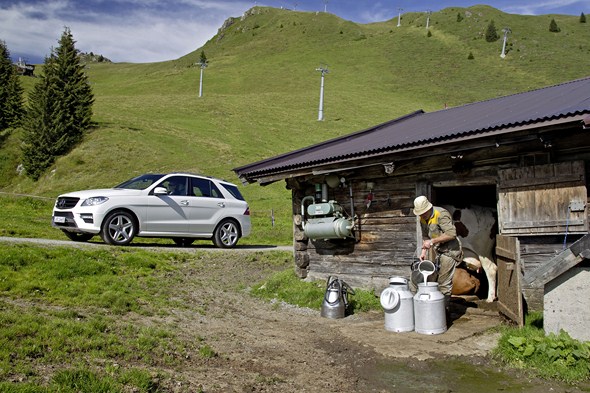
Upgrade as standard: interior with a first-class ambience
The interior design concept clearly combines an authentic SUV experience with a sense of wellbeing that is usually the reserve of top-class Mercedes-Benz saloons. While an expressive dome shape embodies the power of an SUV, the gently sloping contours of the dashboard in the front passenger area afford an outstanding sense of space, thereby highlighting the vehicle’s suitability for long journeys.
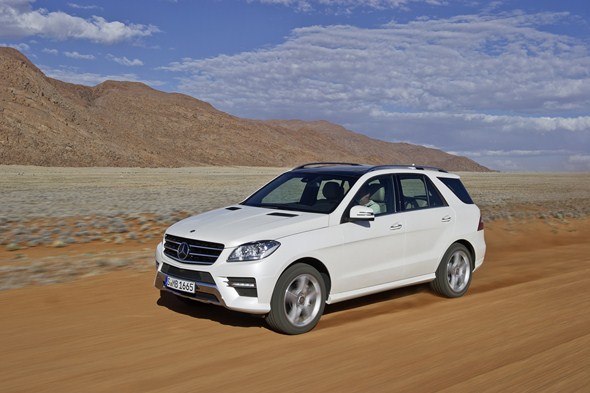
The spacious, bright interior offers substantially more elbow room than its predecessor (an extra 34 millimetres in the front and an extra 25 millimetres in the rear), thus enhancing spaciousness. Eye-catching features on the dashboard include a large trim element that matches the trim used for the doors and therefore creates a harmonious wrap-around effect.
The seats in the new M-Class have been designed to offer high long-distance comfort and optimum lateral support.
All of the key settings can be adjusted electrically. New features include rear seat backrests adjustable for angle and the through-loading feature via the armrest for transporting skis. Folding both backrests as well as the seat cushions forward creates a level load compartment with a capacity of 2010 litres up to the roof lining – a record in this segment.
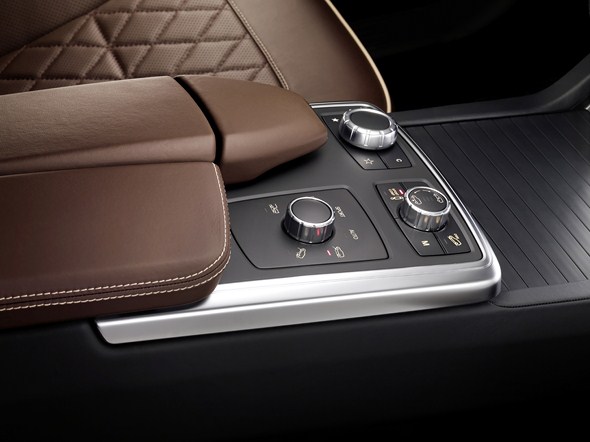
The new M-Class comes as standard with the Audio 20 CD system, which comprises a radio with twin-tuner, a colour display with a 14.7 cm screen diagonal, an MP3/WMA/AAC-compatible CD player, a USB interface with CD Cover Art display (if saved on the storage medium), an AUX-IN socket in the centre armrest and a telephone keypad.
The Bluetooth interface also allows hands-free telephony and Audio Streaming for the transfer of music. One of the particularly interesting features on offer is the Becker® MAP PILOT, a fully integrated navigation module with a 2-D/3-D map display for Europe. The device is housed in a cradle in the glove compartment and is operated using the central controller for the Audio 20 CD system.

The COMAND Online multimedia system with a high-resolution 17.8 cm colour display provides internet access in the M-Class for the first time. Customers can either browse freely when the vehicle is at a standstill or use a Mercedes-Benz App with pages that load extremely quickly and are also easy to use when the vehicle is on the move. As an option, COMAND Online is available with a 6-disc DVD‑changer. This system’s standard features include Speed Limit Assist, which recognises traffic signs and displays them in the instrument cluster.
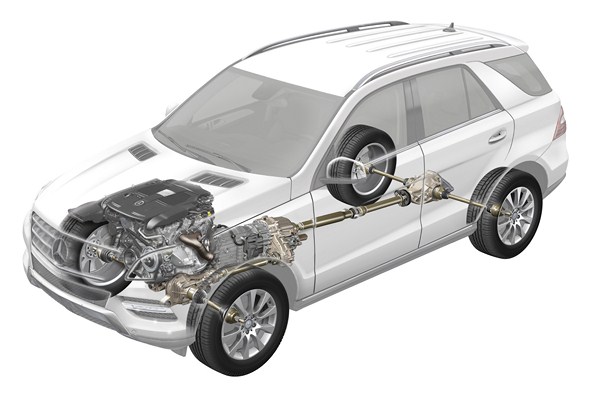
Drive system: high efficiency and oustanding dynamics
The SUV efficiency champion
The third-generation M-Class sets a new benchmark in the SUV segment. The low fuel consumption figures and exemplary emissions figures are particularly impressive.
Compared with the outgoing model, the entire model range consumes 25 percent less fuel on average. A sophisticated engine line-up, engine downsizing, the best-in-class Cd figure of 0.32, extensive BlueEFFICIENCY measures and new development tools such as the “energy-transparent vehicle” all play their part in delivering excellent energy efficiency.
The highlight comes in the guise of the ML 250 BlueTEC 4MATIC, which is 28 percent more economical than its predecessor, boasts NEDC fuel consumption of 6.0 l/100 km (158 g CO2/km) and has a range of up to 1500 kilometres on a single tank – figures that only a few years ago remained the preserve of the compact class.
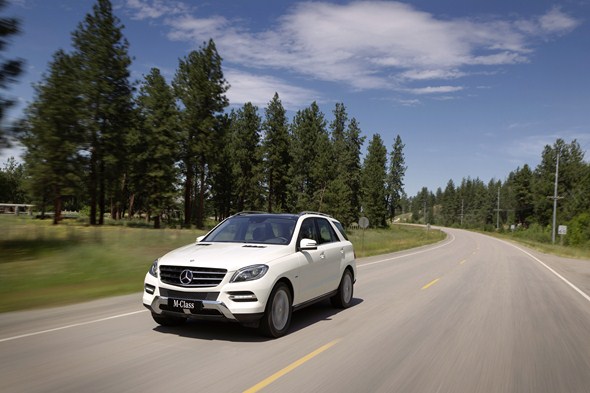
BlueTEC diesel units and the new generation of BlueDIRECT direct-injection petrol engines form the basis for the excellent economy and outstanding life cycle assessment of the new M-Class. In this respect, downsizing takes centre stage as far as the diesel models are concerned:
- In the ML 250 BlueTEC 4MATIC, the 3.0-litre V6 of the previous model is replaced by the thrifty four-cylinder unit already familiar from, for instance, the S-Class.
- The ML 350 BlueTEC 4MATIC features an extensively revamped 3.0-litre V6, which offers far better performance coupled with a substantial reduction in fuel consumption.
Thanks to AdBlue® emission control technology, both diesel models comfortably meet the EU6 standard slated for introduction in 2014.
Data comparison with corresponding predecessor model:
| ML 250 BlueTEC 4MATIC | ML 300 CDI BlueEFFICIENCY 4MATIC (predecessor model) | ML 350 BlueTEC 4MATIC | ML 350 CDI 4MATIC (predecessor model) | |
| Number of cylinders | 4 | 6 | 6 | 6 |
| Displacement cc | 2143 | 2987 | 2987 | 2987 |
| Rated output kW (hp) | 150 (204) | 150 (204) | 190 (258) | 170 (231) |
| Max. torque Nm | 500 | 500 | 620 | 540 |
| NEDC combined consumptionl/100 kmg CO2/km |
6.0–6.5 158 | 8.4–9.1 224–240 |
6.8–7.4 179 | 8.9–9.4 235–246 |
| Fuel saving % | -28 | -24 | ||
| 0–100 km/h s | 9.0 | 8.3 | 7.4 | 7.6 |
| Top speed km/h | 210 | 210 | 224 | 220 |
| Emissions standard | EU6 | EU5 | EU6 | EU5 |
State-of-the-art engine technology
The 2.2-litre CDI engine turns the ML 250 BlueTEC 4MATIC into the most economical SUV in its class. With NEDC fuel consumption of 6.0 l/100 km, the model even outperforms any hybrid model currently offered by the competition. Despite the low fuel consumption figures, this M-Class model boasts a maximum torque of 500 Nm at 1600 rpm and a rated output of 150 kW (204 hp) with outstanding performance: the M-Class accelerates from 0 to 100 km/h in 9.0 seconds before going on to a top speed of 210 km/h.
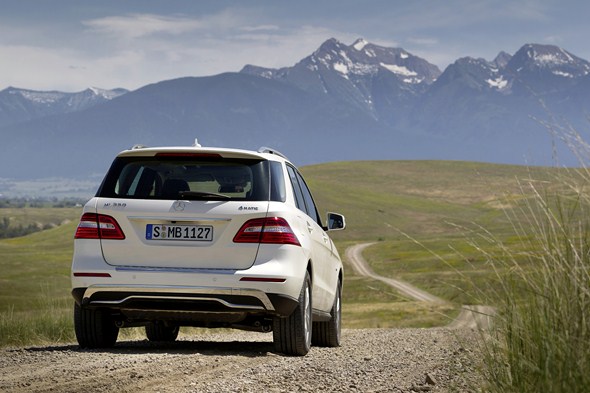
Two-stage turbocharging produces high torque even at low engine speeds. The compressor package – already fitted in the compact GLK 250 CDI 4MATIC SUV – made up of a small high pressure (HP) and a large low pressure (LP) turbocharger contributes decisively to the high output on a par with the 6‑cylinder unit in the predecessor model ML 300 CDI BlueEFFICIENCY 4MATIC. The two turbochargers are connected in series, and each has a turbine and a compressor driven by this turbine.
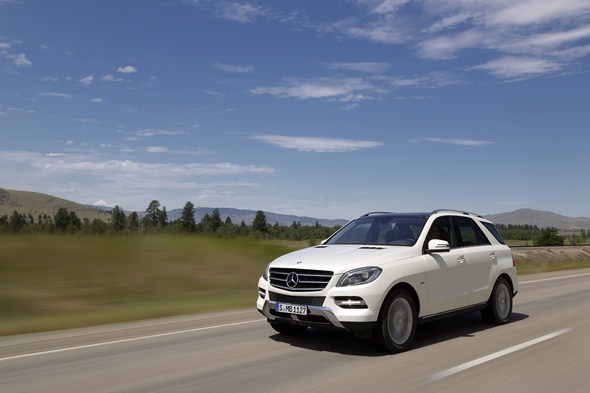
The HP turbine is located directly at the exhaust manifold and initially allows exhaust gas to flow through it; it then rotates at up to 215,000 revolutions per minute. The HP turbine housing features an integral bypass duct, which can be opened or closed by means of a charge-pressure control flap. If the flap is closed, the whole exhaust stream flows through the HP turbine, so that the exhaust-gas energy is available solely for the HP turbine drive. This means that the optimum charge pressure can be built up at low engine revs.
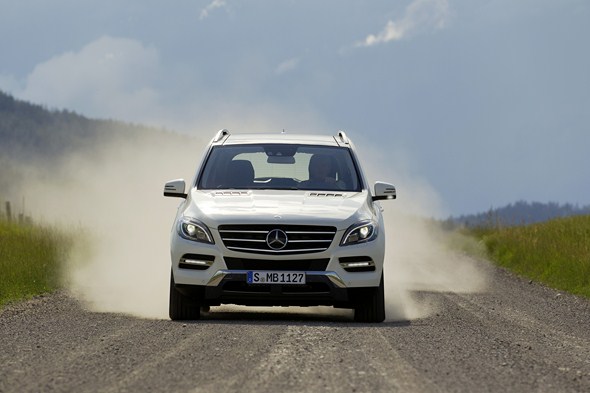
The two compressors are likewise connected in series, and are in addition connected to a bypass duct. The combustion air from the air filter first flows through the low-pressure compressor, where it is compressed as a function of the LP turbine’s output. This pre-compressed air then passes into the high-pressure compressor, which is coupled to the HP turbine, where it undergoes further compression.
The result is a genuine two-stage turbocharging process. The major advantage of this sophisticated, demand-based control of the combustion air supply using two turbochargers is improved cylinder charging, and therefore high torque even at low engine speeds. Fuel consumption is also reduced.
When the car is driven, this concept makes itself felt by harmonious driving characteristics with no turbo-lag, a favourable torque curve across the entire engine speed range, instant responsiveness and excellent performance.
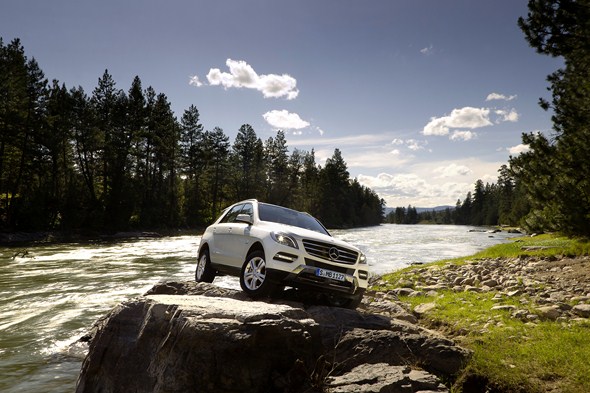
The V6 diesel engine in the ML 350 BlueTEC 4MATIC guarantees effortlessly superior traction. It develops 190 kW (258 hp) and impressive torque of 620 Nm. Despite its extraordinary performance this version boasts combined NEDC fuel consumption of 6.8 litres of diesel per 100 kilometres.
The highly efficient V6 diesel unit delivers effortlessly superior performance: the ML 350 BlueTEC 4MATIC accelerates from standstill to 100 km/h in 7.4 seconds before moving on to a top speed of 224 km/h. While delivering performance on a par with the predecessor model, the ML 450 CDI 4MATIC with V8 diesel engine, the new unit, however, boasts 36 percent lower fuel consumption.
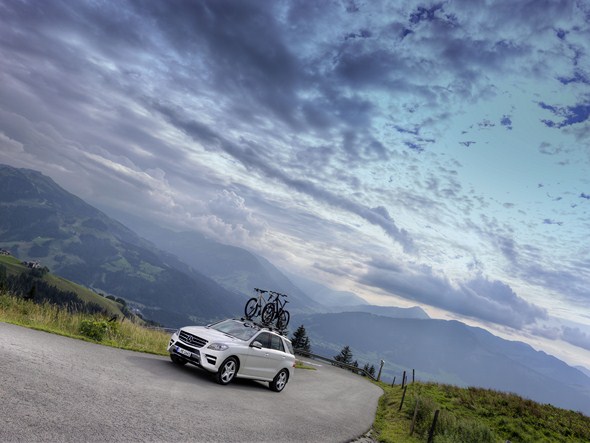
Just like the ML 250 BlueTEC 4MATIC, the ML 350 BlueTEC 4MATIC also ranks among the world’s cleanest diesel models: BlueTEC is a technology developed by Mercedes-Benz to reduce emissions from diesel vehicles, especially nitrogen oxides. AdBlue®, an aqueous urea solution is injected into the exhaust gas stream as part of this process, releasing ammonia, which reduces up to 80 percent of the nitrogen oxides into harmless nitrogen and water in the downstream SCR (Selective Catalytic Reduction) catalytic converter.
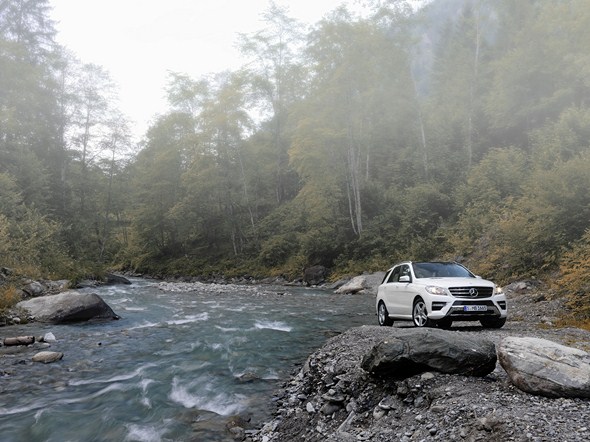
Upshot: both models already comply with the EU6 exhaust emissions standard due to be implemented in 2014. The AdBlue® tank is located under the luggage compartment floor to protect it in the event of a crash, has a capacity of 25.7 litres and is topped up every 25,000 kilometres at the regular service intervals. The filler opening is located behind the side fuel filler flap alongside the tank filler neck and is marked clearly with a luminous blue cap.
This configuration allows the ML driver to top up the tank easily if they take full advantage of the off-road capabilities of the M-Class and are unable to find a service station off the beaten track. AdBlue® is available as a refill container from any Mercedes-Benz dealership; the instrument cluster provides a timely indication of the need to top up the tank.
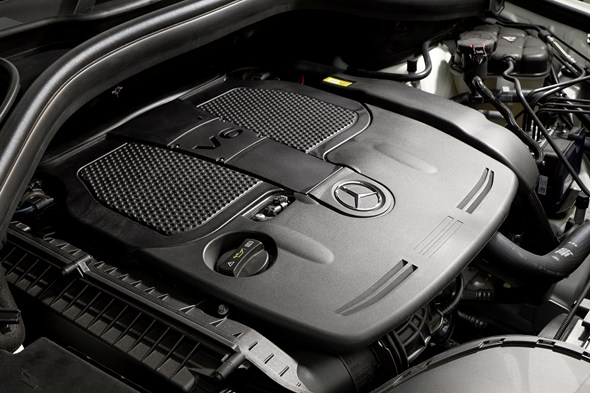
BlueDIRECT engine for the ML 350 4MATIC BlueEFFICIENCY
The ML 350 4MATIC BlueEFFICIENCY petrol-engine model features the groundbreaking technology of the new generation of V engines from Mercedes‑Benz. At the heart of the BlueDIRECT technology package lies the enhanced third-generation spray-guided direct petrol engine with piezo injectors. In combination with multi-spark ignition, this technology offers further possibilities for fuel savings.
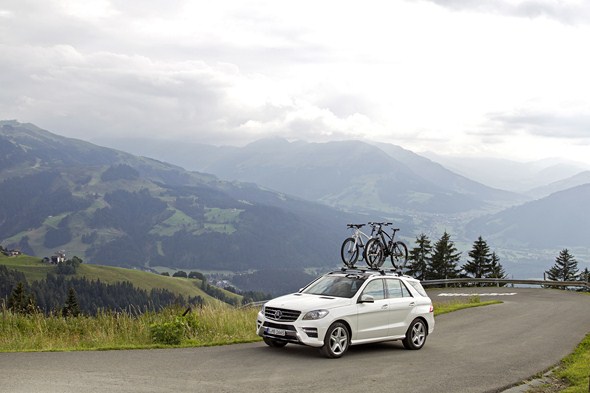
The V6 engine in the ML 350 4MATIC BlueEFFICIENCY utilises a new stratified combustion process with a considerably extended characteristic map and fuel-efficient lean-burn technology (“homogeneous stratified mode” or HOS). As the name implies, HOS is a combination of homogeneous lean-burn and classic stratified combustion.
The first injection is sprayed into the intake stroke, forming a homogeneous basic mixture. Actual “stratified” injection takes place during the compression stroke before ignition, and is a single
or double injection depending on the characteristic map.
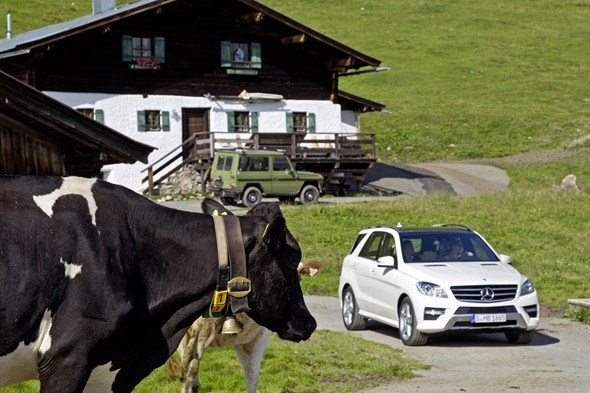
The third-generation direct-injection system also features rapid multi-spark ignition (MSI). How it works: following the first spark discharge and a brief combustion period, the coil is rapidly recharged and a further spark is discharged. The MSI system enables up to four sparks to be discharged in succession within one millisecond, creating a plasma with a larger spatial expansion than conventional ignition.
Controlling this rapid multi-spark ignition enables both the time lapse before the next spark and the combustion duration for the relevant operating point to be optimally adjusted. This provides scope for optimising the centre of combustion and improving residual gas compatibility, especially during stratified charge operation.
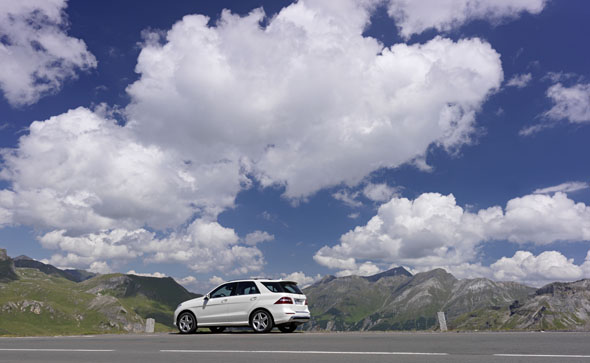
The sophisticated 3.5-litre V6 unit has been designed as a naturally aspirated engine. As a major distinction from the preceding engine in the ML 350 4MATIC, the V-angle between the cylinder banks has been reduced from 90 degrees to 60 degrees. This has enabled the balancer shaft compensating primary vibrations to be omitted. As a result the driver notices an outstanding level of comfort.
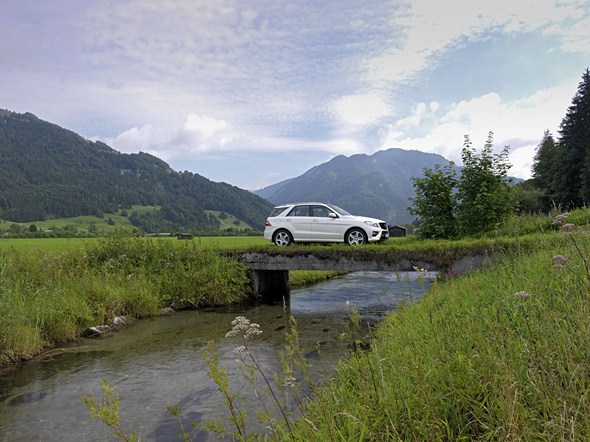
The design highlights of the 3.5-litre V6 include a completely new air intake and exhaust system in conjunction with a variable resonance intake manifold and optimised inflow and outflow. Result: with the same displacement, the output compared with the previous 200 kW (272 hp) model is increased by 12.5 percent to 225 kW (306 hp), while maximum torque has increased by 5.7 percent to 370 Nm (predecessor: 350 Nm) and now is available over a broader engine speed range from 3500 to 5250 rpm.
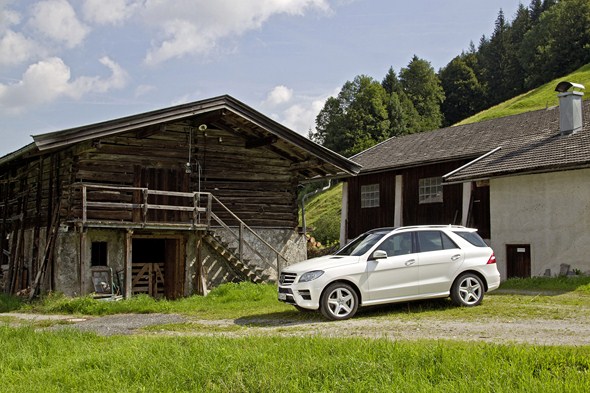
In parallel with this increase in power, Mercedes engineers have achieved an equally impressive reduction in NEDC fuel consumption – by some 25 percent compared to the predecessor model. The new V6 petrol engine in the ML 350 4MATIC BlueEFFICIENCY consumes 8.5 litres per 100 kilometres, making it the most economical petrol model in its class. The model combines excellent consumption figures with dynamic performance, accelerating from standstill to 100 km/h in 7.6 seconds, and with a top speed of 240 km/h. Data for comparison:
| ML 350 4MATIC BlueEFFICIENCY | ML 350 4MATIC (predecessor model) | |
| Number of cylinders | 6 | 6 |
| Displacement cc | 3498 | 3498 |
| Rated output kW (hp) | 225 (306) | 200 (272) |
| Max. torque Nm | 370 | 350 |
| NEDC combined consumptionl/100 kmg CO2 / km |
8.5–8.8 199 | 11.4–12.0 266–281 |
| Fuel saving % | -25 | |
| 0–100 km/h s | 7.6 | 8.4 |
| Top speed km/h | 235 | 225 |
| Emissions standard | EU5 | EU4 |
New dimensions in energy efficiency
The performance of the M-Class engines becomes particularly apparent when looking at the reduced energy requirements coupled with a marked increase in power output per litre for the three M-Class generations since 1997. Comparison of the weight-specific consumption figures (l/100 km per 100 kg) reveals the tremendous development potential of the conventional internal combustion engine:
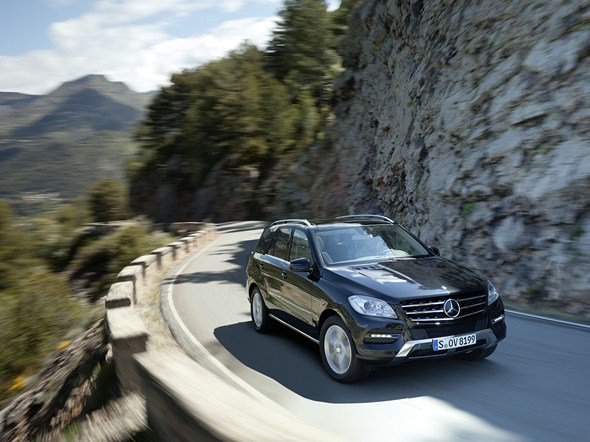
Long-distance champion: a high level of efficiency ensures a long range
The range for a full tank of fuel on the new M-Class is particularly impressive. This parameter is very important for a vehicle that knows virtually no bounds. Here, the ML 250 BlueTEC 4MATIC – the most economical SUV in its class by far – stands out. With NEDC consumption of 6.0 l/100 km, the frugal diesel engine with the standard 70-litre tank can cover around 1170 kilometres before needing to stop for fuel. If the vehicle is fitted with the optional 93-litre tank, the car can even cover up to 1500 kilometres between refuelling stops. The ranges at a glance:
| ML 250 BlueTEC 4MATIC | ML 350 BlueTEC 4MATIC | ML 350 4MATIC BlueEFFICIENCY | ||||
| NEDC combined l/100 km | 6.0 | 6.8 | 8.5 | |||
| Fuel tank capacity in l | 70 | 93 | 70 | 93 | 78 | 93 |
| Range perfull tank of fuel km | 1170 | 1500 | 1030 | 1370 | 920 | 1090 |
Attention to detail: a fine finish adds efficiency
The fuel economy is underpinned by a comprehensive package of BlueEFFICIENCY measures as well as by this state-of-the-art engine technology. In addition to the ECO start/stop function that comes as standard, these measures include the new seven-speed 7G-TRONIC PLUS automatic transmission. Low-friction axle drives, electric steering and tyres with low rolling resistance also play their part in reducing fuel consumption.
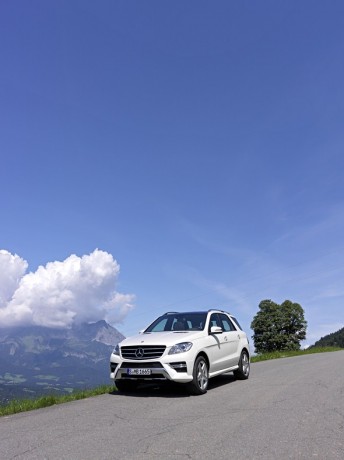
The re-engineered 7G-TRONIC PLUS, standard on all M-Class models, boasts an integrated ECO start/stop function, lower converter slip and optimised efficiency. A central role is played by the new torsion damper, which eliminates torsional eccentricities and vibrations in the transmission even more effectively. The lower the rpm and the lower the number of cylinders, the more severe these can be. This results in a conflict of aims between comfort and fuel-efficient operation.
Mercedes-Benz developers resolved this by using what is called a twin-turbine damper, which is also fitted with a centrifugal pendulum on the diesel models. Depending on the rpm, this moves the centre of mass and allows comfortable operation even in the most economical operating range.
Furthermore, the optimised damping allows a marked reduction in the slip of the torque converter lockup clutch even under low loads, which also contributes to fuel savings. In addition, the optimised damping of rotational irregularities and vibrations in the transmission allows an even faster response to driver commands via the accelerator pedal. Friction-optimised bearings and new transmission oil thermal management also help reduce fuel consumption.
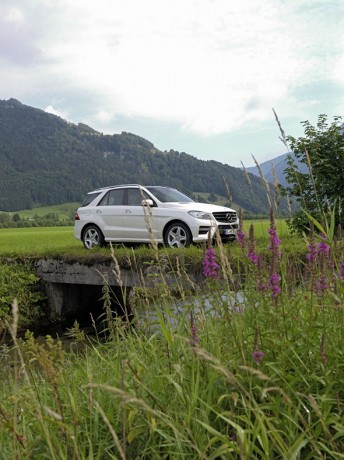
The optimised belt drive system with decoupler, together with intelligent, on-demand control of all ancillary components and pumps, also helps to reduce the energy requirements of the new M-Class. The oil and water pumps in the engine, as well as the fuel pump in the rear section of the vehicle, are only activated according to actual need.
The same control logic is used in the THERMATIC and THERMOTRONIC air conditioning systems. In these, the coolant compressor only runs when necessary. An internal heat exchanger and the sophisticated sensor system including a demisting sensor on the front windscreen ensure optimum efficiency of the air conditioning systems in the interior. A key factor in the diesel engines is also the optimisation that has been undertaken of the flow and counterpressure in the exhaust system with its SCR emission control technology.
A consistent use of lightweight construction techniques has enabled the development engineers to keep the weight of the new M-Class on a par with that of its predecessor, despite more equipment. The links on the front and rear axles, for example, along with the bonnet and wings, are made out of light and yet very strong aluminium alloys, while the cross member for the instrument panel is made of magnesium.
Aerodynamics: the most aerodynamic SUV in its class
With a drag coefficient, or Cd figure, of 0.32, the new M-Class (ML 250 BlueTEC) sets a new best figure for this vehicle class (total aerodynamic drag Cd x A = 0.92, predecessor 0.94). Painstaking simulations undertaken with the digital prototype, along with final touches added in the wind tunnel, ensure a perfect flow of air around the vehicle.
The key factor determining the low wind resistance is the aerodynamic efficiency of the basic bodyshell, including the optimised design of the front bumper with its integrated spoiler, of the A pillars and of the roof spoiler, plus numerous other detailed improvements. These include:
- Sealing around the radiator section with adjustable fan shutter
- Sealed joints between the bonnet and the headlamps
- Front wheel spoilers
- Air outlets in the front wheel well liners
- Redesigned exterior mirror housings
- Optimised roof spoiler
- Side spoilers on the rear window (ML 250 BlueTEC 4MATIC)
- Underfloor and engine compartment panelling
- Aerodynamically optimised light-alloy wheels for the diesel models
Detailed analysis: “energy-transparent vehicle” creates transparency
The “energy-transparent vehicle” development tool, created in-house by Mercedes-Benz, was piloted as part of the M-Class development process. The outstanding opportunities presented by this method, which can detect the possibilities for optimisation in even the most minute component, will be exploited on all new model series in the future.
An exact and meticulous examination of the flow of energy throughout the vehicle (tank to wheel) helps the development engineers to optimise every single assembly that has an impact on fuel consumption, right down to individual components, such as wheel bearings.
The idea for the “energy-transparent vehicle” stemmed from the failure in the past to verify or demonstrate clearly the many factors affecting consumption and the interaction between fuel-saving measures. Using the “energy-transparent vehicle” tool, the engineers can now detect detailed potential optimisation measures by breaking down energy flows into cause and effect and analysing energy interactions within the entire vehicle.
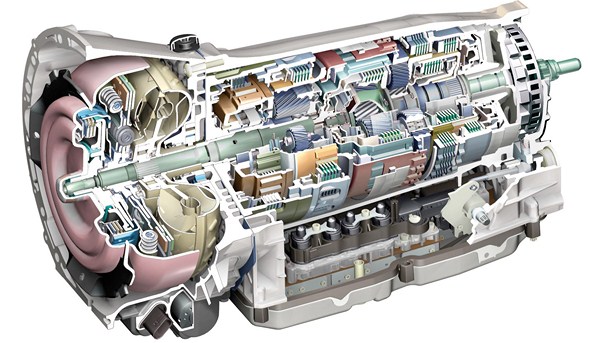
The process draws on complex, highly precise metrology which records some 300 energy-relevant measurement points with a sampling rate of up to 1000 measured values per second. Every minute some 2.4 million measured values are generated, which can subsequently be analysed to reliably pinpoint optimisation potential. The process is complemented by energy simulation models which are validated by means of the measured variables. This enables the energy efficiency of individual major assemblies and components as well
as the entire vehicle to be analysed and quantified. Once the specialists have identified a vehicle component with energy shortcomings, they team up with the relevant specialist departments to devise solutions. This cooperation focuses on design, or the properties of the materials used in individual vehicle components such as wheel or axle bearings. In addition, modified control strategies can also produce the desired outcome.
The “energy-transparent vehicle” process which is exclusive to Daimler enables the development engineers to highlight and leverage optimisation potential both for cars with conventional internal combustion engines as well as hybrid, electric or fuel-cell drives. In future, this process may even give rise to a generally applicable development tool for all machines and help boost energy efficiency across the board. A wide range of applications are conceivable. Whether in industry for power stations, (wind) generators, pumps or conveyor systems, in the home for refrigerators, washing machines, dryers and lawnmowers, or for transportation applications involving ships, trains or planes – the optimisation potential of disparate technologies to save energy could be analysed in detail with the consistent usage of this technique and implementation recommendations made.
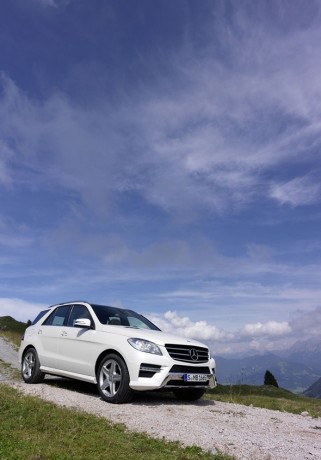
Safety: A reassuring feeling
Just one star is enough
In line with the Mercedes-Benz brand philosophy, the new M-Class represents the embodiment of the Mercedes-Benz holistic safety concept of Real Life Safety, which is derived primarily from what happens in a real accident situation. The extremely robust occupant compartment of the M-Class, together with the front and rear deformation zones, forms an effective basis for the occupant protection system. Both active safety and driver-fitness safety in the new M-Class are further improved by Assistance Systems, already primarily familiar from the S and E-Class.
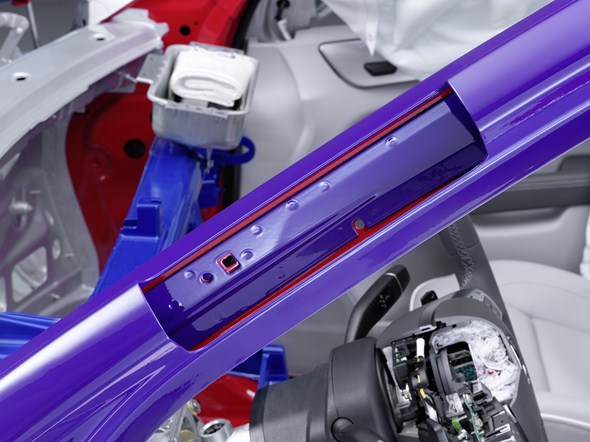
As with all passenger car models from Mercedes-Benz, the philosophy behind the safety concept of the M-Class is broken down into four phases:
- Safe driving: avoiding danger, warning and assisting the driver in good time
- In the event of danger: anticipating and enabling preventive protective measures
- In an accident: providing protection as needed
- After an accident: avoiding even worse consequences and making rapid assistance possible
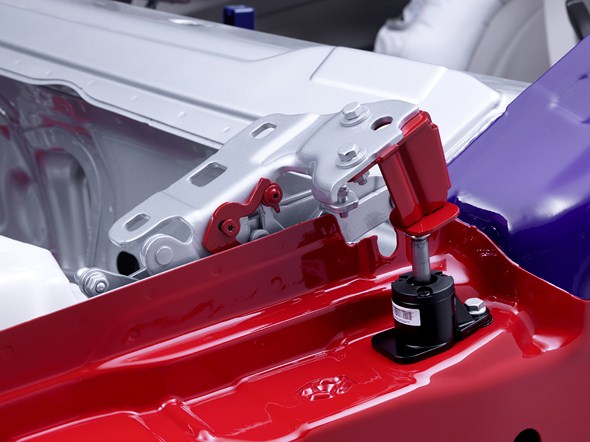
The high level of safety already achieved in the previous model has been increased even further. The many “invisible” Mercedes-Benz solutions in particular bring measurable benefits in real accident situations. To support new technologies or the evolution of existing systems, the engineers carried out numerous crash tests which went way beyond the tests normally specified, such as the roof-drop test for example, as well as various rollover tests.
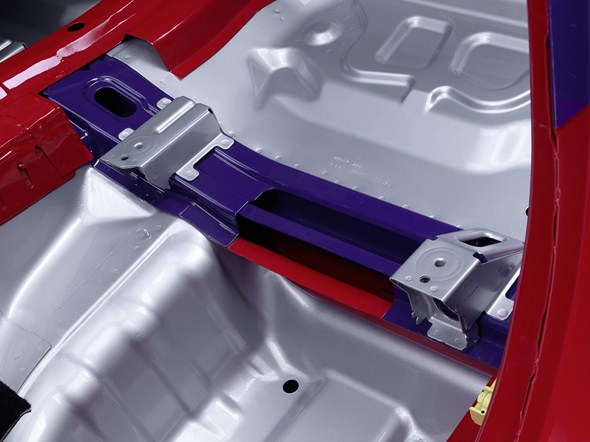
When it detects the need to do so, a rollover sensor system can activate side and window airbags, as well as belt tensioners. In total, as part of the M-Class development Mercedes-Benz tested 36 totally different loads under real test-conditions.
This included comprehensive simulations for the digital prototype. Following this intensive development programme, the M-Class now has the potential to pass all international ratings with the best possible results.
The M-Class is also able to demonstrate the highest possible protection potential when it comes to more vulnerable road users such as pedestrians or cyclists. In addition to yielding areas in the front section, folding exterior mirrors and smooth contours, the risk of injury caused by the vehicle has been reduced by adjusting the bonnet and increasing the distance to the components in the engine compartment.
In addition, for the first time in the SUV segment, an active bonnet is fitted as standard equipment. It is able to reduce the acceleration forces of an impacting pedestrian or cyclist by intercepting them earlier.
“Electronic crumple zone”
As ever, the best accident is one which does not happen at all. The safety engineers at the Mercedes Technology Center are working intensively on this rather simple sounding statement, which in practice is actually a lot more difficult to implement. Both active safety and driver-fitness safety in the new M-Class are further improved by the numerous active and passive assistance systems:
- ATTENTION ASSIST, warns the driver of drowsiness
- Speed Limit Assist, displays road signs in the instrument cluster
- Tyre pressure loss warning system
- Intelligent Light System with specific lighting functions to match the relevant road and weather conditions
- Night View Assist Plus with automatic person recognition
- ADAPTIVE BRAKE with the functions Hill-Start Assist, priming, brake drying and hold function
- Brake Assist (BAS) to support the driver in critical braking manoeuvres
- DISTRONIC PLUS with BAS PLUS
- Lane Keeping Assist warns the driver as soon as it detects that the driver has unintentionally left a recognised marked lane. In addition, Active Lane Keeping Assist can react with lane-correcting brake application
- Blind Spot Assist warns the driver when vehicles are detected in the area of poor visibility, the so-called “blind spot”. Additionally, Active Blind Spot Assist can counteract a possible collision by specific application of the brakes on one side of the vehicle, if the driver does not react to the warning.
- Park Assist with PARKTRONIC, a system which can detect parking spaces and carry out the steering manoeuvres required for the parking process, simply leaving the driver to operate the brake and accelerator
- Reversing camera, e.g. with “back-in” mode with dynamic guide lines for reversing into narrow parking bays or to aid with the coupling of trailers
- Adaptive brake light warns vehicles behind in an emergency braking situation with flashing brake lights
Standard equipment forming part of the safety concept of the new M-Class includes the anticipatory safety system PRE-SAFE®, which combines active and passive safety synergies to reduce the loads exerted on the vehicle occupants in the event of an accident by up to 40 percent.
Depending on the potential accident situation detected, the following reversible measures can be initiated for preventive occupant protection:
- Driver and front passenger seat belts are tensioned
- Windows are closed
- Sliding sunroof is closed
- Front passenger seat is adjusted (when fitted with Memory package)
Body: high energy absorption in the event of a front impact
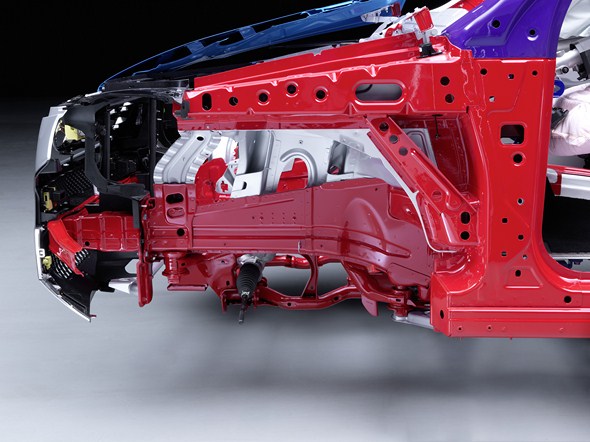
The extremely robust occupant compartment of the M-Class, together with the front and rear deformation zones, forms an effective basis for the occupant protection system. The focus of the work here has been the tangible reduction of the loads exerted on the occupants.
In the case of front impacts, the engineers were able to achieve more uniform deceleration, and therefore a lower peak load on the occupants. This was made possible by means of:
- Design of the front axle carrier as a crash element, which is able to deform in a specific manner and in the case of an offset crash, for example, can divert the energy to the side of the vehicle opposite the side of impact
- A novel aluminium gearbox crossmember mount with offset function: isolated against noise and vibration during normal operation, in the event of a crash this component is activated via hooks so that the centre tunnel can absorb additional energy in this area (diesel versions only)
- Guide ramp on the brake booster, thus preventing unwanted block formation between the brake booster and the damper dome. The brake booster is also rotated to minimise possible brake pedal intrusion
- A crash joint ensures that the mudguard is pushed away at the driver’s door, and prevents the door from jamming after the impact. For the most part the doors can be opened without much effort
- Ultra-high-strength steels in the A-pillar enhance the stability of the passenger compartment in both front impacts as well as in different rollover scenarios, primarily enabling doors to be opened easily after an offset crash
- Projected sills create a direct load path to the front wheel. As a result, any possible forcing or intrusion of the wheels into the footwell can be avoided
- Optimum energy conversion in the event of a front crash despite relatively short front-end length, thanks to enabling the load paths from the crashbox to the longitudinal body member, from the wheel to the sill, and due to the deformable subframe, which guides forces into the centre tunnel via the engine/transmission joint
- The energy-absorbing steering column deforms up to 100 millimetres when subjected to external forces, thus freeing up additional deformation space for energy conversion. As a result, the loads on the driver can be reduced in the area of the head, neck and thorax
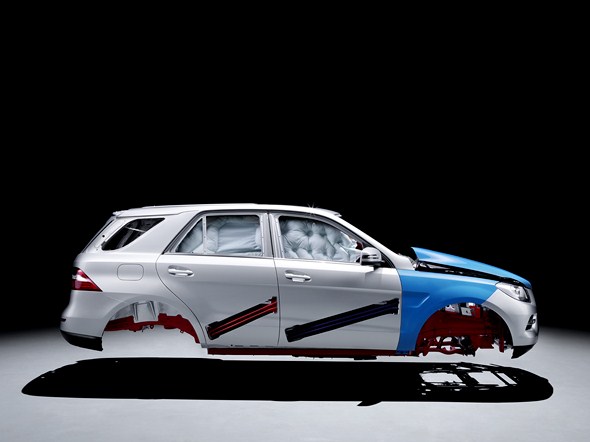
Side-impact protection thanks to intelligent bodyshell
Similar to the design of the front area of the new M-Class, the vehicle’s intelligent bodyshell design also performs impressively in side-impact accident scenarios. The specific distribution of high rigidity and high deformability helps to ensure that the occupants benefit from favourable kinematics in the event of a side impact:
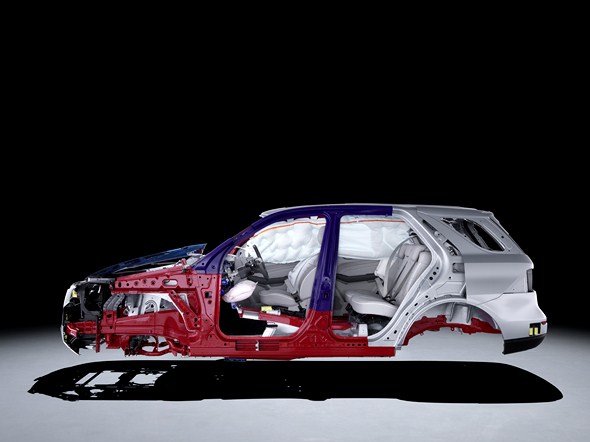
- The lower part of the B-pillar, an important component in side impacts, is highly compressible, whereas its upper part is extremely rigid. As a result, intrusions and the speed of intrusions in the lower area are reduced, while in the upper area high-strength steels on the exterior sides of the pillar prevent it from buckling unfavourably in a side impact. In addition, this design solution increases the stability of the passenger compartment in the event of a rollover
- The stiffening of the floor structure by means of a supporting element made of an ultra-high-strength material running across the entire width of the vehicle, and ultra-high-strength reinforcements in the driver’s seat crossmember, help to reduce deformations, primarily in the event of a pole impact. As a result, the occupant survival space benefits from even better protection, and the thorax load on the occupants is reduced
- The geometry and body connections of the pillars and the roof frame made of ultra-high-strength material have been optimised to provide the best possible crash safety
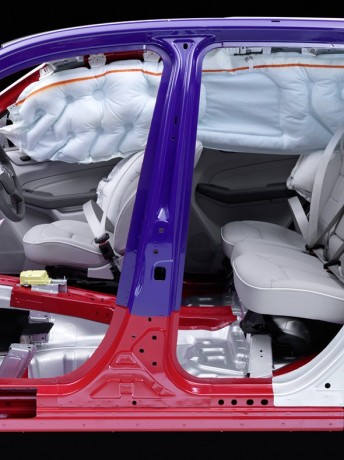
Brilliant finish: the rear assembly
The rear area of the M-Class also protects the sturdy passenger compartment in crash situations thanks to specific deformation work, therefore minimising the loads on the occupants. A special impact test conducted to check tank leakage gives an indication of the exceptional load capabilities of the rear part of the M-Class body.
The test involved running a crash carriage into the rear of the M-Class at 80 km/h. The tank system survived this fatal impact without suffering any leaks.
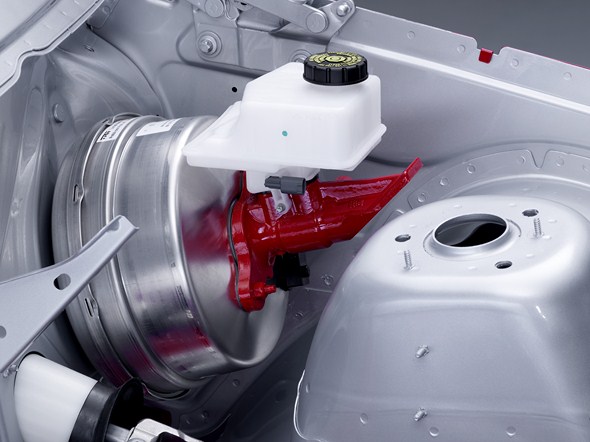
To enhance rigidity, increase the energy absorption capability and improve deformation behaviour, the multi-piece rear longitudinal members feature a continuous closed cross-section with stepped plate thicknesses (tailored blanks).
The spare wheel well forms an integrated part of the steel floor, and a steel flexible bumper bracket carries the rear bumper covering and is connected to the rear structure via two steel crashboxes.
Comprehensive restraint systems for occupant protection
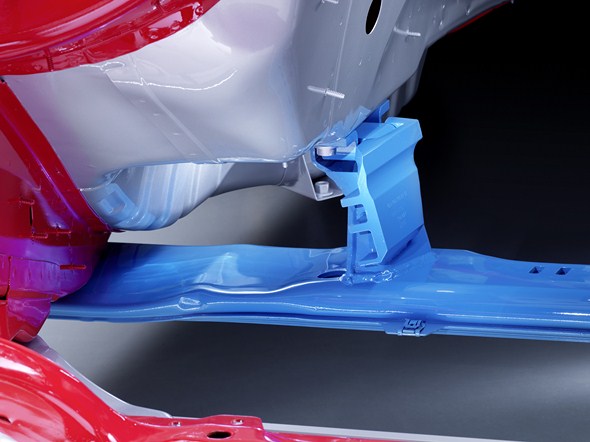
The passive occupant protection systems, together with the “electronic crumple zone” and intelligent body design which have already been described, provide optimum protection potential, placing the M-Class at the top of its market segment.
As part of this, a number of new deployment strategies are used. For example, the system can detect an impending rollover in the event of crash and if necessary deploy the head, side and window airbags, as well as the seat belt tensioners.
Thanks to the new generously-sized side airbags and the window airbags with extended area of coverage, in the event of a crash the occupants can be more uniformly supported from the shoulder area down to the pelvic area, and thereby better protected. In side impacts too, the danger of injury is reduced thanks to extended coverage.
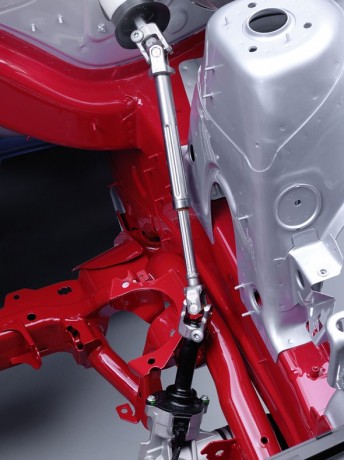
Additional protection potential is also provided for rear seat passengers with seat belt tensioners and force limiters on the outer seat positions. The integration of optional thorax bags in the tilt-adjustable folding seat backrests enables optimum airbag positioning for each backrest position. The components of the passive occupant protection systems include:
- Two-stage adaptive airbags for the driver and front passenger
- Kneebag for the driver
- Sidebags for driver and front passenger (combined thorax/pelvis bags)
- Sidebags in the rear row of seats as an option
- Windowbags across both rows of seats from the A- to the C-pillar
- 3-point seat belts on all five seats
- Pyrotechnic reel tensioners and permanent belt force limiters as well as electrically reversible belt tensioners in the front, reel tensioners and single‑stage force limiters for the outer seats in the rear
- ISOFIX child seat anchorage
- Belt height adjustment for the driver and front passenger
- Belt status display for rear-seat passengers in the instrument cluster
- Automatic child seat recognition (optional) with deactivation of the front passenger airbag if a special Mercedes-Benz child seat is used
- In a rear-end collision, a passive head restraint system developed specifically for this purpose can reduce the forces exerted on occupants
Occupant protection even after a crash
As part of the POST-SAFE® functions, the new M-Class can activate a variety of systems which can contribute towards avoiding post-accident risks. After a more serious crash, the hazard warning lights are automatically activated to warn surrounding traffic. At the same time, the doors are automatically unlocked so that the emergency services have the best possible unrestricted access to the passengers. And thanks to partial opening of the side windows, the interior is better ventilated after deployment of the restraint systems.
On detecting a collision, the central control unit switches off the fuel system to reduce the risk of a possible fire. After determining the cylinder positions, the engine management system opens the injection valves of those cylinders which are not under compression and discharges the high-pressure fuel area by direct evacuation of the remaining fuel in the combustion chamber.
This reduces the risk of fuel escaping. To avoid fuel losses, all M-Class models are also fitted with cut-resistant fuel lines in all relevant locations. This also helps to reduce the risk of a possible fire breaking out.
Design: impressive credentials
From Economy to First Class
The vehicle body design for this third-generation model, with the very typical shape of its C-pillars, is full of character and immediately recognisable as an M-Class. Its styling, high-quality appeal and excellent ease of operation combine to give it a forceful presence.
The interior in particular is even more impressive than in the predecessor models and combines the best of both worlds, boasting a strong off-road heritage at the same time as making its passengers feel as if they are travelling in a luxury premium saloon.
Ground aluminium or exquisite woods as well as the finely detailed switches and trim highlights blend with electrifying surfaces and powerful, harmonious lines to create a high-class interior ambience and a tremendous sense of wellbeing.
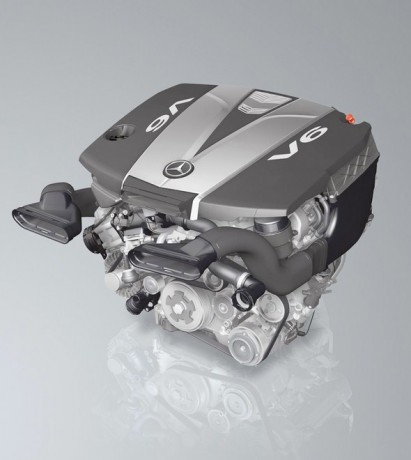
The front of the vehicle is dominated by the design of the radiator grille with its centrally positioned Mercedes star, giving it that typical M-Class look. The new styling of the headlamps conveys a high-quality and exclusive impression, especially when the Intelligent Light System is taken as an optional extra.
The LED daytime driving lights are set in chrome inserts integrated into the bumpers. A deeper, broad, chrome-effect underguard continues down from the lower edge of the radiator grille, so serving to reinforce the impressive overall appearance.
Character line: effortlessly superior and high-quality body design
Seen from the side, the elongated lines give formal emphasis to the on-road credentials of this vehicle, whose compact proportions are defined by a large wheelbase and short overhangs. The C-pillar that is so characteristic of this model series takes its cue from early generations of the M-Class and differentiates it very clearly in stylistic terms from its competitors.
At the same time, the way the roof line slopes down to the rear underlines the sporty appeal of the new M-Class. No pillar is visible in the transition from the rear side window through to the rear windscreen.
This, together with the similarly wrap-around effect of the two-part rear light unit with LED fibre-optic technology, and the lowered roof with its large roof spoiler, add up to an overall harmonious design.
The rear bumper, which features an integrated chrome-effect load sill guard in a new “wing design”, defines the characteristic appearance of the SUV’s rear end. The chrome-look finish of further product features, such as the roof rails, the beltline trim strip or the load compartment handle, emphasise the high-quality appeal of the exterior.
The available wheels range from light and aerodynamically optimised 43.2 cm (17-inch) wheels through to 50.8 cm (20-inch) wheels with an elegant, high-quality appeal. As an option, 53.3 cm (21-inch) AMG wheels can be fitted to emphasise the sporty look of the new M-Class.
A feeling of wellbeing as standard: the interior
The interior design concept combines an authentic SUV experience with the sense of wellbeing of a high-quality Mercedes-Benz saloon. While an expressive dome shape embodies the power of an SUV, the sloping dashboard in the front passenger area affords an outstanding sense of space, thereby highlighting the vehicle’s suitability for long journeys.
The evolution of the dashboard in Mercedes-Benz off-road vehicles, from the early days of the G-Class through to today’s new M-Class, makes it clear how much aspects of comfort and wellbeing have now come to the fore:
- In the G model dating from 1979, square-edged shapes defined the flat dashboard. The angular instrument panel was laid on top of this, while the dashboard console, also angular in shape, and the glove compartment area were hung beneath. As if pieced together from modular sections, the individual elements reflected the clear look of
a commercial vehicle. Their simple practicality dispensed with any embellishments, instead giving off an air of rustic charm with a rather metallic-like effect. At the time, this was totally appropriate for an off-road vehicle.
- The dashboard in the first generation M-Class dating from 1998
was also primarily functional in nature, and made only tentative concessions to a design based around comfort. Nevertheless, the first hints of the more comfortable and friendlier interior design to be found in saloons were noticeable. Curves and sweeping lines helped to avoid an impression of austerity. Trim elements were not often incorporated into the sober visual design, however, and functionality continued to dominate.
- The design of the instrument panel in the new M-Class is completely on a par with its counterparts found in luxury-class saloons: modern, friendly, equipped with high-quality materials and stylishly designed. At the same time, matching details reflect the superior character of the premium SUV.
The modern Mercedes-Benz definition of the appropriate interior of an SUV becomes evident as soon as the pleasantly high seating position is accessed via the wide-opening doors. The spacious, bright interior provides noticeably more elbow room than its predecessor (34 mm more in the front, 25 mm more in the rear) and thus an enhanced sense of space and comfort.
The driver takes to the wheel behind a 4-spoke multifunction steering wheel with twelve trapezoidal control buttons for trip computer, radio and telephone. The 7G-TRONIC PLUS automatic transmission is controlled via the DIRECT SELECT DIRECT SELECT lever as well as DIRECT SELECT shift paddles on the steering wheel.
The broad instrument panel stretches out behind the steering wheel. With its clear emphasis on width, it continues the horizontal lines from the exterior design in the interior. Exciting areas and powerful lines highlight the vehicle’s sporty aspirations.
An eye-catching feature of the instrument panel is a large decorative trim element that is then continued along the doors in a very harmonious wrap-around effect. These generously proportioned trim elements, in a three-dimensional design, are available in four high-quality wood finishes, or in aluminium. The interior of the new Mercedes-Benz M-Class can thus be appointed to reflect either exclusive refinement or sporty sophistication, according to the customer’s taste.
The door openers and seat adjustment switches have been inset with precision craftsmanship into the side trim elements. The door centre panels feature distinctive decorative stitching, with a separate, exclusive look for the Sports package.
All clear: instruments and COMAND screen
The instrument cluster with its two clear and extremely legible round dials and a large, 11.4 cm monochrome display between them, impresses with the high quality of its design. Dominating the centre of the instrument panel in the centre of the vehicle is the large colour screen for the infotainment system.
There is a choice between CD radio, CD radio with integrated navigation system or the COMAND control and display system (14.7 cm screen diagonal for the CD radios, 17.8 cm for the internet-enabled COMAND Online). The control and display concept was developed specifically with user-friendly operation in mind. Infotainment, navigation and communication systems are intuitive and easy to operate using the metal Controller located on the centre console. Two buttons are used to switch the display on and off.
Vertical rectangular air intake vents either side of the large screen serve to emphasise the more functional aspects of the SUV. The outer air vents are the same shape but in this case horizontally positioned, thus giving an added design flair. The dashboard console and air intake vents feature edging with a quality Silver Shadow finish.
The row of high-gloss silver switches in the dashboard console are characterised by their ergonomic design and discernible precision. The same applies to the air conditioning and ventilation setting, as proven in Mercedes-Benz saloons.
The centre console incorporates an integrated arm and handrest, in front of which is located the Controller and various switches, such as those for the off-road programmes and AIRMATIC air suspension. All controls feature a quality, uniform look.
Numerous stowage facilities, high degree of variability and temperature-controlled cup holders
Numerous, easily accessible stowage facilities in the M-Class can accommodate bottles, mugs, keys, coins and much more. Each of the four doors can also accommodate a large 1-litre bottle. Lifting the handrest in the centre console opens up a stowage compartment which houses easily accessible connections for mobile audio devices.
To make long journeys and extensive off-road excursions more enjoyable, the centre console also features two cup holders which can keep drinks either cool or warm at temperatures of between 8° and 55° Celsius.
The seats in the new M-Class are designed to provide a high level of comfort on long journeys as well as excellent lateral support. All important parameters can be electrically adjusted, including height, backrest angle, seat cushion angle and reach. Generous seat adjustment travel of more than 350 millimetres lengthways and more than 90 millimetres in height ensure that drivers of all sizes will always find the ideal seating position.
A high level of variability characterises the rear seats, which are fitted with an armrest and cup holder. The angle of their backrests can be adjusted, and they can be also folded in the ratio 1/3:2/3, thus creating a through-loading feature for long objects, such as skis, without having to sacrifice all of the rear seat positions. Folding both backrests as well as the seat cushions forward creates
a level load compartment with a capacity of 2010 litres up to the roof liner.
Exclusively available for the new M-Class are three seat and two sports seat variants in six different colour combinations. The sports seats reserved for the Sports package feature a different stitching pattern which is also incorporated into the door centre panels.
Model range, prices, equipment and appointments
At premium level
There are two diesel versions and one petrol version of the new M-Class available at market launch: ML 250 BlueTEC 4MATIC, ML 350 BlueTEC 4MATIC and ML 350 4MATIC BlueEFFICIENCY. All of the models impress with their extensive range of standard equipment and attractive, optional equipment packages. There is also a limited-edition model ‘Edition 1’ with exclusive equipment and appointments.
With fuel consumption according to NEDC of 6.0 l/100 km (158 g CO2/km), the extremely fuel-efficient ML 250 BlueTEC 4MATIC delivers an output of 150 kW (204 hp) along with 500 Nm of torque. It can accelerate from a standing start to 100 km/h in 9.0 seconds, while its top speed is 210 km/h.
Even faster on the move is the ML 350 BlueTEC 4MATIC, although with a fuel consumption that is almost as frugal, at 6.8 l/100 km. With a maximum output of 190 kW (258 hp) and torque of 620 Nm, the V6 diesel can accelerate to 100 km/h in 7.4 seconds and reach a top speed of 224 km/h. With 225 kW (306 hp), the petrol-engined ML 350 4MATIC BlueEFFICIENCY has an average consumption, according to NEDC, of just 8.5 l/100 km and achieves a top speed of 235 km/h.
Variety is the spice of life: the colours and materials
M-Class customers can choose from two standard, non-metallic paint finishes – calcite white or black – or pay extra for one of the following metallic paint finishes: iridium silver, obsidian black, palladium silver, pearl beige, tanzanite blue, tenorite grey, citrine brown or diamond white BRIGHT.
The standard interior of the SUV features upholstery in ARTICO man-made leather in combination with black fabric and an aluminium trim with light longitudinal grain. Optional extras include the following colours and materials: ARTICO man-made leather in alpaca grey, almond beige or black; leather in alpaca grey, almond beige or black; or leather in black/alpaca grey, black/almond beige or black/tobacco brown/marron.
As for the trim, there is a choice of brown open-pore ash wood or high-gloss wood in brown eucalyptus, dark graphite poplar or brown burr walnut. Furthermore, the upper and lower sections of the dashboard as well as the door beltlines can be enhanced with an ARTICO man‑made-leather trim with topstitching.
THERMATIC: prime clime as standard
A balanced interior climate is assured thanks to the standard-fit THERMATIC automatic climate control with 2 climate zones, a combination activated charcoal filter to reduce dust and odours, a solar sensor, rear air vents and a demisting sensor. For even more sophisticated climate control, the THERMOTRONIC system is available as a cost option.
This system also includes 4-zone temperature control for the driver, front passenger and rear passengers as well as three individually adjustable climate modes – DIFFUSE, MEDIUM, FOCUS – a dew point sensor, additional B-pillar vents, a booster blower in the centre console for the rear compartment with separate controls, convenient air recirculation with an outside air quality sensor and residual engine heat utilisation.
For the eyes and the ears: good entertainment and the best information
The new M-Class comes as standard with the Audio 20 CD system, which comprises a radio with twin-tuner, TFT colour display with a 14.7 cm screen diagonal, an MP3/WMA/AAC-compatible CD player, a USB interface with CD Cover Art display (if saved on the storage medium), an AUX-IN socket in the centre armrest and a telephone keypad. The Bluetooth interface also allows hands‑free telephony and Audio Streaming for the transfer of music.
The Audio 20 CD system can be optionally upgraded with the addition of a 6-disc CD changer, Media Interface, the “Logic7” Surround Sound system from audio specialists Harman/Kardon®, digital radio (DAB) or comfort telephony in the armrest.
Then there is the Becker® MAP PILOT, a fully integrated navigation module with 2D/3D map displays for Europe. This system, which is offered as a genuine accessory, can be docked into a cradle in the glove compartment and controlled through the central control unit of the Audio 20 CD system.
The navigation route is shown in both the central display and the instrument cluster, while route recommendations are issued acoustically through the vehicle loudspeakers. Also included: automatic tailback avoidance (TMC Pro) and voice-controlled address entry. Updates to map data, application software and other features are possible via the internet on a home computer, since the module can be taken out.
The COMAND Online system, with a high-resolution 17.8 cm TFT colour display, offers internet access in the M-Class for the first time. Customers can either surf freely while the vehicle is stationary, or call up a Mercedes-Benz app, the pages of which build particularly quickly and are easy to use even while the vehicle is on the move.
The integrated apps include Google™ Local Search, Facebook access (from 11/2011) and weather, as well as the ability to download and adopt into the navigation system a route that has been previously configured in Google Maps and sent to the car, or specific destinations. Further Mercedes-Benz apps will be successively introduced and will then be available for use by all customers. Telephones that are compatible with the COMAND Online apps are listed on the website www.mercedes-benz.com/connect. COMAND Online is available as an option with a 6-disc DVD‑changer.
The system includes Speed Limit Assist as standard, which recognises traffic signs and displays the applicable speed limit in the instrument cluster.
Stable prices: ML 350 BlueTEC 4MATIC costs little more than its predecessor
Customers can order the new M-Class from 11 July of this year, with deliveries commencing in November 2011. Despite the upgraded equipment and appointments, prices for the ML 350 BlueTEC 4MATIC remain practically the same as for its predecessor (an increase of just 50 euros).
The prices at a glance:
| Model | incl. 19% VAT | |
| ML 250 BlueTEC 4MATIC | €46,200 | €54,978 |
| ML 350 BlueTEC 4MATIC | €49,350 | €58,726.50 |
| ML 350 4MATIC BlueEFFICIENCY | €47,700 | €56,763 |
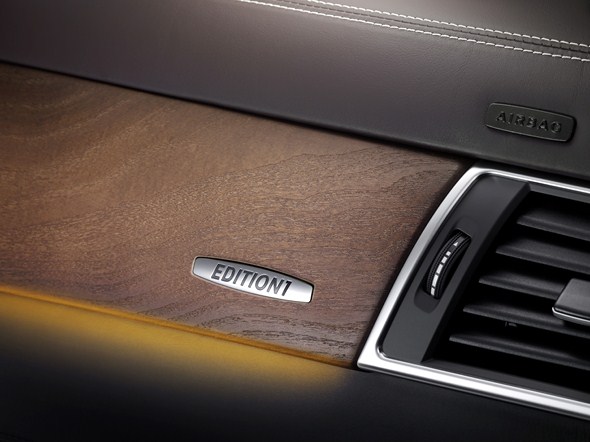
Exclusive model to mark the launch: Edition 1
They have already become something of a tradition and are valued by our customers: the limited-number Edition 1 vehicles that mark the beginning of any new model series.
In the case of the new M-Class, the offer includes an AMG Exterior Sports package with a specific front apron, rear apron and side sill panels in vehicle colour, as well as 50.8 cm (9J x 20) high-sheen AMG light-alloy wheels in a 5-spoke design and 265/45 R 20 tyres. The sporty, dynamic look of the car is rounded off by sports brakes with perforated brake discs and special brake calliper covers, and metallic paintwork.
The interior is similarly impressive, featuring designo leather upholstery in either marron or porcelain with contrasting decorative stitching in a diamond-shaped pattern. The instrument panel, door centre panels, interior beltlines and centre console are also upholstered in leather.
The wood/leather steering wheel in nappa leather with DIRECT SELECT shift paddles, wood trim in open-pore brown ash or high-gloss anthracite poplar and the black designo roof lining round off this luxurious package of appointments.
The footwells have black velour floor mats with metal ‘designo’ badges. Functional enhancements to the interior include a Memory package, seat heating for the driver’s and front passenger seats, sidebags in the rear and the automatic child seat recognition system. The M-Class Edition 1 may be combined with any diesel or petrol engine.
The M-Class Edition 1 can likewise be ordered from 11 July, with prices starting at €55,700 (€66,283 incl. 19% VAT for the ML 250 BlueTEC 4MATIC Edition 1).
Complete: the standard equipment
- Adaptive flashing brake lights
- Airbags for driver and front passenger
- 4MATIC all-wheel drive
- Anti-lock braking system (ABS)
- Acceleration skid control (ASR)
- ATTENTION ASSIST can detect typical signs of drowsiness or increasing inattention based on the driver’s steering and then warn the driver in advance if microsleep is imminent
- Audio 20 CD
- Heated left and right exterior mirrors, electrically adjustable from inside, painted in the vehicle colour, with aspherically curved mirror glass and integral indicators
- 7G-TRONIC PLUS automatic transmission
- Brake Assist (BAS) with automatic detection of emergency-stop situations and braking assistance
- Spectacles compartment in overhead control panel, illuminated
- 2 cup holders at the front
- Chrome-look roof rails
- Diesel particulate filter (diesel models only)
- DIRECT SELECT gearshift with DIRECT SELECT steering-wheel shift paddles and DIRECT SELECT selector lever on the steering column
- Downhill Speed Regulation (DSR)
- ECO start/stop function
- Chrome-effect electronic key
- Electronic Stability Program (ESP®)
- Electronic Traction System (4ETS)
- 4 power windows with convenience control and automatic reversing function
- Transmission mode switch for Economy, Sport and Manual modes (E/S/M) for ML 250 BlueTEC 4MATIC
- Electric parking brake with convenience release function (released automatically when starting off)
- Folding rear-seat backrests with 1/3 : 2/3 split, adjustable inclination and cargo position
- Pedestrian protection with Active Bonnet
- Heated rear window with timer control
- Rear window wiper with intermittent wiper control, activated automatically when reversing
- ISOFIX child seat anchorage points in the rear and TopTether securing points at the top of the rear backrest
- Mechanical childproof locks in the rear doors and electrical childproof locks on the rear power windows
- Kneebag for the driver
- Instrument cluster in 2-tube design with 11.4 cm (4.5-inch) multifunction display
- LED rear lights including tail lights, brake lights, indicators and third brake light
- LED daytime driving lights
- 43.2 cm (17-inch) 10-spoke light-alloy wheels with 235/65 R17 on 7.5 J x 17 (ML 250 BlueTEC 4MATIC/ML 350 BlueTEC 4MATIC)
- 45.7 cm (18-inch) 10-spoke light-alloy wheels with 255/55 R17 on 8 J x 18 (ML 350 4MATIC BlueEFFICIENCY)
- Steering column manually adjustable for height and reach
- 4-spoke multifunction steering wheel in nappa leather with steering-wheel shift paddles and 12 function buttons
- Off-road mode with off-road button, optimises the modes for anti-lock braking system (ABS), Electronic Stability Program (ESP®), Electronic Traction System (4ETS) and electric steering (ML 350 BlueTEC 4MATIC/ML 350 4MATIC BlueEFFICIENCY) when driving off-road
- Electric steering with variable steering assistance and variable steering ratio
- PRE-SAFE® system with reversible belt tensioners for front seats, closing function for power windows
- Tyre pressure loss warning system
- Windscreen wipers with rain sensor
- Clear-lens headlamps with H7 projector-beam technology
- Side impact protection
- Sidebags for driver and front passenger
- Sun visors with illuminated vanity mirrors which can be pivoted to the side
- Socket under rear seat bench on the right and in the load compartment
- Cruise control with SPEEDTRONIC variable speed limiter
- TIREFIT with electric pump
- Door brake with locking system
- Up-front and roll-over sensor system, supplies information to the central control unit to ensure fast activation of the restraint systems such as airbags and belt tensioners in line with the current situation if a frontal impact is detected or if the vehicle rolls over
- Fully electrically adjustable front seats
- Heat-insulating green tinted glass all round, incl. rear window made from single-layer safety glass
- Warning buzzer and warning indicator in the instrument cluster if occupants are not all wearing their seat belts
- Windowbag
- Central locking with interior switch, automatic locking (deactivatable) and crash sensor with emergency opening
Designed to give customers what they want: attractive equipment and appointments packages
- AMG Exterior Sports package:
– AMG bodystyling, front apron, rear apron and side skirts in body colour
– 48.3 cm (19-inch) 5-spoke AMG light-alloy wheels with a high-sheen finish, with 255/50 R 19 on 8.5 J x 19
– Sports brakes with 45.7 cm/48.3 cm (18-inch/ 19-inch) perforated brake discs with brake calliper cover
- designo Exclusive package
– Upholstery in single-tone designo leather
– designo roof lining in DINAMICA black
– Extended appointments in designo leather, including dashboard, beltlines, door centre panels and armrests
– designo floor mats with “designo” badge and edging in designo black leather
- Anti-Theft Protection package including anti-theft alarm system with tow-away protection and interior monitoring system
- Driving assistance package Plus including DISTRONIC PLUS, PRE-SAFE® Brake, Brake Assist (BAS PLUS), automatic child seat recognition, Active Lane Keeping Assist and Active Blind Spot Assist
- Load compartment management: EASY-PACK load-securing kit including EASY-PACK load-securing rails, fastening elements, telescopic bar and inertia reel
- Light package incl. Intelligent Light System with bi-xenon headlamps, active light function, automatic headlamp beam control, cornering light function, LED indicators, headlamp cleaning system and Adaptive Highbeam Assist
- Memory package including electrically adjustable front seats, front head restraints, steering column and exterior mirrors with Memory function as well as exterior mirrors with parking position, 4-way lumbar support for front seats, controls on the doors and positioning of the front passenger seat in PRE-SAFE® situations
- ON&OFFROAD package including transmission mode switch and animation on the COMAND display, manual mode for 7G-TRONIC, 100% centre differential lock, adapted 4ETS, off-road reduction ratio (low range), underguard under engine, underride guard and special off-road algorithms for ABS, ETS, ESP and air suspension
- Smoker package incl. ashtrays in place of front/rear stowage compartment and cigarette lighter in the front
- Interior Sports package
– Upholstery in DINAMICA microfibre/ARTICO man-made leather in black or upholstery in nappa leather/leather in black
– Sports seats with reinforced lateral support in the 1st seat row and unique seat design with contrasting stitching in the front/rear
– Unique door centre panel
– Luxury 4-spoke sports steering wheel
– Sports pedals in brushed stainless steel with rubber studs
– Floor mats in cord with Mercedes-Benz badge
- Mirror package: automatically dimming interior mirror and exterior mirror on driver’s side as well as electrically folding exterior mirrors left and right
- Lane Tracking package including Lane Keeping Assist and Blind Spot Assist
- Winter package including auxiliary heater, remote control, heated windscreen washer system and heated front seats
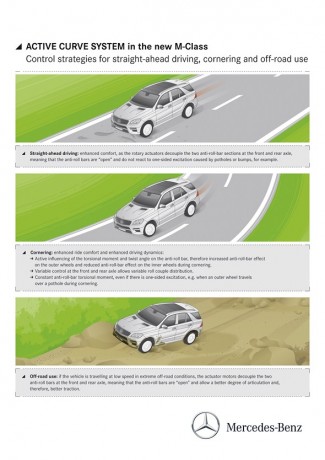
The best in information and entertainment: optional infotainment systems
In addition to the Becker® MAP PILOT and COMAND Online systems described, further features available include the following:
- Digital radio (DAB) for the DAB, DMB and DAB+ standards
- Rear Seat Entertainment System including two 20.3 cm displays integrated in the front head restraints, DVD player, two sets of headphones and remote control
- Harman Kardon® Logic 7® surround sound system including 12-channel SP amplifier and 2-channel booster with a total output of 830 watts in conjunction with 14 high-performance loudspeakers. Dolby Digital 5.1 and DTS listening experience possible if Audio 20 APS or COMAND APS is specified
- Convenience Telephony in the armrest with universal interface for various cradles, extended telephone functions, charging function and external aerial for optimum reception
- Media Interface: universal interface in the glove compartment for various mobile audio devices including consumer cable set (e.g. iPod, USB stick)
- TV tuner for analogue and digital reception (only in conjunction with COMAND)
Desirable: the key individual features available as cost options
- ACTIVE CURVE SYSTEM, dynamic handling control system with dynamic anti-roll function (only in conjunction with AIRMATIC ADS)
- AIRMATIC with Adaptive Damping System (ADS) and all-round self-levelling
- Active Parking Assist including PARKTRONIC
- Ambient lighting for trim in 3 colours, lighting for two cup holders, rear footwell, air vent thumbwheels and front door sills as well as warning/exit lighting in the rear
- Trailer coupling with electric unlocking
- Cup holders with warm/cold temperature control and pelletier element
- designo appointments: wood/leather steering wheel, black fabric roof lining, black piano lacquer wood trim
- Wood/leather steering wheel in nappa leather with DIRECT SELECT shift paddles
- KEYLESS-GO access and drive authorisation system including door handles with chrome insert
- Light-alloy wheels:
– 43.2 cm (17-inch) 5-spoke with 235/65 R 17 on 7.5 J x 17
– 45.7 cm (18-inch) 10-spoke with 255/55 R 17 on 8 J x 18
– 48.3 cm (19-inch) 5-twin-spoke with 255/50 R 19 on 8 J x 19
– 48.3 cm (19-inch) 5-spoke with 255/50 R 19 on 8.5 J x 19
– 48.3 cm (19-inch) 7-spoke with 255/50 R 19 on 8.5 J x 19
– 50.8 cm (20-inch) 5-twin-spoke with 265/45 R 20 on 9 J x 20 - AMG bodystyling light-alloy wheels:
– 48.3 cm (19-inch) 5-spoke AMG with a high-sheen finish, with 255/50 R 19
on 8.5 J x 19
– 50.8 cm (20-inch) 5-spoke AMG with a high-sheen finish, with 265/45 R 20
on 8.5 9J x 20
– 53.3 cm (21-inch) 5-twin-spoke AMG with a high-sheen finish, with 265/40
R 21 on 9J x 21
– 53.3 cm (21-inch) 5-twin-spoke AMG in titanium grey with a high-sheen
finish, with 295/35 R 21 on 10 J x 21 - Heated multifunction steering wheel
- Night View Assist Plus with automatic person recognition
- Electric panoramic glass sunroof with convenience closing feature and automatic rain-sensor closing function (tilt position), electric roller sun blind and automatic reversing function
- Reversing camera with guide lines on the display
- Rear sidebags left and right
- Heated rear seats
- Climatised (heated and ventilated) front seats, perforated leather
Heat insulating dark tinted glass for rear side windows and rear window
